#from what i can see native american cultures and the sami culture here in the nordics are actually very relevant and cutting edge
Explore tagged Tumblr posts
Note
I occasionally come across posts that claim that Frozen 2 is racist. One example being is Iduna herself, how she was retconned to be indigenous despite her white presenting self. Another is a video I saw on TikTok saying how they had her marry Aganrr aka her colonizer (even though I sincerely doubt Agnarr would follow what Runeard tried to do her people). And another time I saw a Youtube comment saying how the Northuldra are not Saami but Native Americans cosplaying as Saami.
I've said this before, but I'll reiterate my main viewpoints when it comes to this topic because the response was back in 2022, so might as well refresh it.
My viewpoint on this topic is this -
If you are not Sámi, then I don't think it is appropriate to speak on how well the representation was done. We should let the Sámi voice their own opinions, and not try to interject our own biases or talk over them. This goes for both negative and positive comments.
I understand where people are coming from here. All they want is to make sure that a group of people are being represented well and respected. They want to be sure that Disney is not just trying to cash in on a half-assed job at representation at the expense of a group that was often marginalized, discriminated against, and colonized.
However, I do think that when we try to defend on behalf of others, we often create problems that were not considered one in the first place, due to our own biases. What do I mean?
I often bring @hb-pickle's post (linked below), where she emailed Professor Veli-Pekka Lehtola, one of the people on the Sámi Advisory group that helped work on F2. He gave incredible insight on the development of F2, and was very happy with the work they did and the treatment they received.
He mentions within his response three main concerns they had during development.
That Yelena was a villain at first.
That the Northuldran attire was at first even more vague than it is now, and looked more like a non-specific arctic attire.
That the Reindeers were running in a circle at the end, as this was not realistic.
You can read the original response to see more details on these and how the team navigated them.
Out of these three issues - not one of them is about Iduna saving and marrying her 'colonizer', or about Iduna presenting white. These issues are things that are brought up mostly by western audiences. Thus, western audiences are creating a problem , and thus speaking over the group they are trying to protect.
In fact, even the film team did this to some extent. With the second issue that I mentioned above, the film team explained to the advisors that the reason they did not want to specifically represent Sami clothing and colors with the Northuldra, is because they did not want to 'culturally appropriate' them.
Thus, the team was making a decision on what the Sami should consider offensive, much like how western audiences are doing the same with Iduna's character.
I would advise seeking out Sami opinions. I have linked some articles below that you can check out.
“Reindeer are better than people:” Indigenous Representation in Disney’s Frozen
Disney's 'Frozen 2' thrills Sámi people in northern Europe
The last link is from a tumblr blog that is now closed. However, you can get a little bit of info from this user before the read more, unless someone has their full article somewhere.
43 notes
·
View notes
Note
i read your piece on transdisability and trace, and it explained things well for me- you are good at explaining things in depth. however, i have a question on the topic of trans race (as a black person who also uses a transid label). please don't take this in bad faith. i hold no hatred for those who id as trace. i'm just curious about things regarding it, and how to understand! sorry if anything is worded oddly.
how would a person trans race (whether poc2white, poc2poc, white2poc) go about expressing their incongruence in a way that Doesn't come off as/is.... racist? for example, as someone who partially identifies as an animal, sometimes i express this by wearing animal ears or talking about things that relate them back to how i am an animal, or how ive experienced these things that animals do. but how nonhuman animals and animals cultures exist are wildly different.
however, if a transrace person wanted to express their racial incongruence by wearing things closed off to members not apart of that culture (like certain native american items such as the headdress being closed off to non natives, or in the black community it being looked down upon for nonblacks/whites to wear braids in the way we do as them having ties to slavery & tribes across the sub saharan as well as nonblacks being able to face less repercussions wearing our hair vs us facing them) would that not be.... wildly inappropriate to do? or be racist if they were doing things related to the race they see themself as, such as emulating closed cultural things or speaking of the experiences of (bodily) x race folks as if it were their own, or even wishing they had experienced them?
im aware race is a social construct and its function is to oppress and separate, but it can come off as odd when people aren't that race try to take claim of those cultures and races, whenever (in the case of poc2poc/white2poc, or even otherace2 white ethnic groups such as the sami) these people tend to have already had so much of that culture taken away from them, typically by the dominant racial group. from what i see i feel like it'd veer less into possibly racist territory for trace folks to context with other cultures that aren't theirs without taking claim to them, or even making desires to have different features like a different skin type or hair type known without trying to take claim to an ethnic grouping or other race. but then again... i don't know trace people, only vaguely observed. I'm just wondering how in these circumstances would People who identify as trace not just be racist. I'm sorry that this got super wordy! I'm just curious and went off on a tangent on how i viewed it and all. have a nice day!
This ask has taken me a while. Because it's very long, at least on mobile. In the future, I'd really appreciate asks with multiple questions to be cut into smaller asks, or things that can be condensed to be condensed at least with a TLDR. this has been making my executive dysfunction... do what it does best.
(Not mad)
Further, when I mention race in here (and all my posts) I mean cisrace unless I specify trace people specifically. If you get triggered or dysphoric by talking very bluntly about race like I will be, this may not be the post to read.
I also want to note I'm always a little hesitant to touch on the topic of trace & similar race & ethnicity inconcruence. It's probably the most controversial and it's easy to troll and target, and it forces me to release more information about myself than I'm super comfortable with? If that makes sense.
Race is also a very... subjective and touchy topic generally that many people have different experiences with unlike age and species. So a LARGE part of this is just me bouncing ideas off the wall to hope they break some bricks. There's no right or wrong answer. My opinion on this subjective topic is not the one truth. Especially because not every trace person is the same, and will navigate their identity differently.
I want to start answering this with a correction real quick. You mention war bonnets, i assume when talking abt an ambiguous headress.
1. Clarify next time. "Headdress" is not a n8v only word, it generally is a word for any head-dress... in other words, ordimental hats.
2. There's no "Native American culture" we have MANY cultures. War bonnets are plains tribes pieces. Further, they're so closed that not just anyone can wear one. I wouldn't. It would be like saying any Christian can just walk up to the pope and steal and wear his hat. Like, most wouldn't do that because they understand that's a hat that is specific to someone's job connected to spirituality. (I only use this comparison because it's an easy thing to invision.)
3. Appropriation does not necessarily come from the action done, but benefits gained. Non native people can own spiders web charms! They're not closed to specific people who earn them, or a part of sensitive ceremonies. It's a baby's thing. The issue comes when non native companies start selling dreamcatchers and outcompeteting native sellers. The issue of appropriation happens here because native people are hated for having our cultures, and suffer for that- but what is seen as "consumable" and "marketable" from us can be sold while we continue to face an ongoing genocide. That's the issue.
4. I'm not black, so correct me here if I'm wrong. But the way appropriation fits in here is explained similar. White people wearing black styled braids or dreads often do so because it's "trendy" or to fill some other kind of social niche they will benefit from- while black people wearing the hairstyles will be still discriminated against for it. A white woman with cornrows has a better chance to be picked up for a job than a black woman with cornrows because of racism at play, but when like so commonly these days, random pieces of mostly black American culture is scraped for trends for mostly white people, the white woman may benefit online from the "trend"- and at the end of the day she can just go back to her natural hair styles, while the black woman wears it to protect her hair and keep it healthy, and can't just have "white hair" any day. The white person can safely benefit from the trend and kick it to the curb to be "outdated" whenever, which the black people who had it scraped from is now forced to deal with the fallout of- and usually face MORE lash back from people now that it's "outdated."
The differences here and a few things I want to point out are...
The trace person isn't doing this by trend we can assume. (While I can't encourage styling your hair in ways that aren't meant for your texture and may damage your hair and scalp) this person is also likely to face social knockback.
Not all trace people choose to take /any/ steps to transition. I'm not shaming those who do things to validate themselves, but many choose not to, this kind of interaction is not necessary and therefore shouldn't be held to trace people as a whole, but rather to the individual depending on your personal feelings on the topic. I am trans species and I don't personally clothe myself in any way that validates that... it does nothing for my dysphoria. Many trace people are similar. Ask yourself if you think transgender people are controversial to yourself if they choose to transition physically because the patriarchy exists.
Not all trace people are white, so we can't really approach these with this binary "white people vs everyone else" view.
Not all trace people are trace to an existing or any race. Many people consider themselves raceless in different ways or not having a human race, or a race from a fictional setting, etc. Hard to appropriate when your race is "wolf."
I really can't speak much on the idea of white 2 poc trace people- its not my experience and I don't know much about it.
I feel like a lot of this can be summed up with the help of asking yourself if you see them as valid or not. Because if you see a trace w2poc person as still white and don't validate them, you're gonna see a lot of these issues the same way people claim transgender people are "appropriating being a woman." Even if they claim to be understanding they'll still insist a trans woman as a man. Would it be tone deaf for a trans woman to say she wished she experienced more misogyny? Yeah it could probably feel that way. It's all ill say on that, because I have not ever been nor am I a woman, and I've never wished my experiences with race was worse. While I can understand how someone may find it validating (even negative attention is attention, and after being starved of attention towards a silent facet of yourself, you may crave anything), it can be upsetting to see though. It's less of a real wish from what I've seen, and more a cry of "anyone, anything, can anyone see me? Even if you hate me?"
I absolutely do believe that all trans identities should be treated softly and with an understanding about the violence of the walls we've put up in the past. But just like how being transgender has intersections with sexism... I feel like we need to talk about a controversial statement I'm about to make.
I believe there's an intersection of transness and race. (And disability but this is not the topic/time for that.)
Let's look at the way people react to well known trace people. Oftentimes, immediate disgust. The transphobia, same as ever exists in this intersection to say, "look at this crazy person! They think they can change the way they are! They're wrong and deviant!" But racism is also present. Almost always, especially from white crowds, there's a surge of racism flung at the individual- under the guise of "gross I hate transness!"
I've seen people describe the intersection of transphobia and misogyny as "transphobes treat trans people they way they wish they could treat cis women. Because they see them as women just enough to be misogynistic and violent, and trans enough to justify that." And I want to say I think similarly, many people treat trace people poorly the way they wish they could treat other races, or even their own. It's an excuse to be racist. A trans->black person will be seen as black enough to be hated for their blackness, and trans enough to be considered a joke.
I will also finish off here by saying I am not uncritical of the actions of much of the community. I've vented to people before about how it can be frustrating to see people waltz in and act in ways that put a bad taste in my mouth. But I've also interacted with lots of very good faith trace people who are very mindful and understanding of their identity. The loudest voices are trolls, and it concerns me moving into a time where transid is becoming slightly more visible that people are almost entirely unable to ignore bait or recognize trolling. I have seen genuine people who are... interesting in the way they choose to interact with race.. but I chalk them up to being uneducated and kids most of the time.
For the most part I see this with transjapanese people who's only exposure to the idea of being Japanese is anime, usually children's anime as well, which gives them a really skewed perspective on the racial experience. I've also met people who have a very in depth knowledge they've gathered from respectfully asking others, reading articles and stories by others, etc. It's usually just a victim of misinformation, lack of information and confusion of the topic.
I also want to point out how in different countries, different experiences can exist. Going back to the idea of transjapanese people, a lot of people begin to pull comparisons to the experiences of asian americans.. but we live in a world where Japanese people in Japan /are/ the majority, and /are/ the preferred race of many in the country when it comes to race based bigotry. A white person absolutely could suddenly find themselves treated poorly for their race in japan as soon as they're anything other than a tourist. It's worth noting the way race works outside of America. A lot of discussions tend to focus here, but the American experience with race is not a universal one. A Japanese person in Japan is not likely to be called an English slur for Asian people. In other countries, that may change.
The topic of nativeness and blackness are both very unique in their foundation in America and that American foundation being about suffering. But I also feel like they're special in their lack of very clear cut borders.
While it's a hot topic, nativeness is hard to define. Blood quantum is a twisted tool of white supremacy, there is no "percentage when you stop being native." Lacking identity with your nativeness, losing your care for your ancestor(s) is, to many, where it starts/ends. This is unique because of how many, still to this day, native kids are kidnapped and unable to connect to their cultures. They're placed in white religious families and essentally wiped of their "nativeness." These kids do not stop being native, until they choose to stop being native. A mixed child is not less native if their skin is lighter or darker than their native parent. They stop being native when they choose to stop being native. A mixed child's child, listening to oral stories from their native grandparent is not less native in this moment. They're not ever. They're not white until they decide to be. It's hard to describe to you. In a world that wants to genocide us, physically, culturally, you can't judge it based on physical build, you cannot judge it on cultural connection. If you uphold being native in spirit, you are native, to an extent. Many native nations have a long history of accepting members of other tribes, other counties, other races. If you fight alongside us, in a world against us, to the oppressor you become my sibling. To me, you become my sibling. Does that make sense? It's why so many have to reconnect. It's why reconnecting is so hard. No blood quantum is required to join the Cherokee nation, for lots of us, what makes someone native is a very... heavily debated topic. Some n8vs have a very hard line, saying as soon as you disconnect culturally you're gone forever, or if you didn't grow up on a reservation. Some are very loose, saying anyone can reconnect. I'm looser on it, and it makes me happy (though, anxious) to see transnative people. We're in a cultural(+) genocide. I don't think you can afford to be picky with who keeps that culture alive, so long as they're respectful.
Like I said earlier, I'm not black. But I want to, with my understanding, go further from here by saying "black" is a vague word that means different things in different places. A lot of the time here in America it means specifically black Americans with a history connected to American slavery and segregation, etc, hence 'black culture' but in different parts of the world it may mean anyone dark skinned. It could mean anyone of African decent, it could include people from south America, I know there was a discourse a few years ago about if native Australians could call themselves black. If someone in America fit the bill, many people would consider them black, not asking or caring if they're a first generation immigrant or if they're a tourist or even African at all. Many mixed people are considered black regardless of if they self identify as being black or mixed. Etc.
So similarly I think there's a sort of... I don't know, food for thought about these 2 ideas of race especially in an American context that are especially flexible and poorly defined with the socal contrast of race.
Sorry if I missed anything, I tried to comb through the text block multiple times to catch every point but I'm very, very dyslexic. I may have missed things, feel free to send them more condensed. Further, I'd like if you'd read this post on race as a social construct if you haven't already, reader. Seeya! And of course, thank you for the question I hope I answered it as well as you'd like.
All of our culture and idea of race is a construct- but that doesn't mean it doesn't exist. [Link]
6 notes
·
View notes
Text
We arrived here before Columbus!
A common theme I've seen a lot recently is talks of who "arrived in North America before Columbus". While I don't think the question in and of itself is harmful, I think the root of this question has VERY harmful origins.
If you are involved in indigenous spaces, you may have heard "(insert group or culture) was in North America before Columbus.". Nearly always the claim is false. There is some evidence to suggest spanish explorers who landed in south America explored higher north, although nothing concrete to my knowledge. There is also a few viking encampments found in the far north, including one in L'Anse aux Meadows that was dated to the year 1000. So unless these are the two situations being discussed, approach the subject with a LOT of skepticism.
During colonization a lot of colonizers knew what they were doing was horrible. Sometimes you'll hear a narrative that it was 'just how things were' or 'people didn't know better'. However, we know this isn't true as we have documents from the time that very clearly question how horrible some of the actions were. In order to avoid taking accountability for these actions you see a lot of stories or 'relics' pop up around this time trying to push the idea that Europeans were in North America for much longer and thus have a right to do what they were doing. Many of these stories were altered older stories while others were pure fabrication. Most 'relics' are fakes or indigenous pieces being stolen.
The book of Mormon is a far more glaring example story wise, but smaller less well known examples exsist and are still spread around today. The story of Madoc is one I saw recently discussed. While Madoc IS a old story, the story was altered during colonization to claim he arrived in North America. Prior to this change he simply found an island paradice. However, this story encouraged the idea of "Welsh Indians". That certain groups of indigenous people have welsh ancestory because of Madoc arriving. The idea of 'Welsh indians' helped encourage further expansion west across North America.
In reguards to 'relics', you will often hear of 'rune stones' being discovered all across North America. There is a location here in Oklahoma but others exsist. Most of these 'rune stones' are found isolated from anything else that would suggest people had stopped in the region which is the most glaring evidence against their authenticity. Carving these stones would require stopping and such stops would have evidence beyond just a carved stone.
A more shocking one was a story I heard through FaceBook. The poster believed the Sami people were in America first, then indigenous people brutally killed all of the Sami and stole thier culture. This is, of course, completely unfounded and little more than a racist conspiracy heory.
These are just examples I can name off the top of my head, however I have heard similar stories about Africa, Asia, Russian, Australia, etc.
Some evidence does suggest indigenous populations could be from a mix of different groups, but this mixing would have occured so long ago (like 200,000 years) that trying to make a tie to any modern culture is just false. Often the urge to claim "(insert group) were the original Native Americans" or "(insert group) was actually here for hundreds of years prior to Columbus" comes from a desire to feel like the colonization of the Americas was not as bad as it was. It was bad, and that needs to be faced. Trying to use unproven stories to make yourself feel better about it is attempting to dodge the fact this event in history was as bad as it was.
Please be cautious believing such stories, and ask yourself why you want to believe them so much.
To note: this is pretty North America focused because I'm not super well informed on what similar stories exsist in South America. I'm sure they exsist, I'm just not knowledgable on them.
2 notes
·
View notes
Text
Constellation of the day: a brief introduction on sky cultures.
To begin with: every culture that’s ever existed on this planet seems to have found images to associate with groups of stars. Each culture gave those constellations names borrowed from mythology or everyday-life objects. So we have a number of Sky Cultures, some of which have been somehow systemised. I’d at least like to name them, as a form of respect and because they are intrinsically interesting and important.
Native American cultures are the Blackfoot culture, Inuit, Navajo, Tukano, Tupi-Guarani.
In Asia, the Bugis, Chinese (old and Contemporary), Indian Vedic, the Japanese (that is similar to the Chinese in dividing the Moon’s path in 28 “stations”), the Korean (also similar to the Chinese one), the Mandar, Mongolian, and Siberian.
In Europe we have constellation systems as the Belarusian, the Norse (love that one), the Romanian, the Ruelle chart (first ever attempt to reconstruct Greek constellation with geometrical figures), the Sami, a whole separate star chart for Sardinia, then there’s the Western- that’s the most used constellation system adopted by the International Astronomical Union, and three other variations of this particular system.
In the Middle East, we find three Arabic cultures (Al-Sufi, Ancient, Lunar Stations) and the Egyptian culture.
In Oceania, there are the Anutan, Hawaiian, Kamilaroi/Euahlayi, Māori and Tongan.
On the same Earth and under the same sky, apparently no human group could go without looking at the stars. If you’re interested, you may find more here (other references included). Even more bibliography and information can be found on my other main source, from which I learnt most of what I know about Sky Cultures, the mobile app Stellarium. Can also ask me for other links and such if you feel like it.
No constellation is, obviously, a faithful portrait of the hero, object, or animal it’s associated with. One could hardly think of Cassiopea as a W. To see why constellations are named as they are, one should look at the night sky not only with imagination in general, but with The imagination of those who named them first, influenced by their myths, their heroes and their lives. Slawik and Reichter give in their premise the pregnant example of Orion, that up there in the sky is stopping the attack of the Taurus, all the while chasing the beautiful Pleiades, and running from the Scorpion’s stinger. Looking at the sky as a group of humans looked at it, means having in front of you (or above your head for that matter) a sort of rotating, ever changing picture of their culture and beliefs. Stories and legends and are told and handed down in what we now schematise as dots and lines, and I find that re-learning to read them from scratches can be quite mind-opening.
See y’all later with another post, probably another introduction on catalogues and names, this time more technical.
~Ad Astra~
1 note
·
View note
Text
Folklore Fact #2 - Bear Shapeshifters/“Werebears”
Gasp. Yes, another non-werewolf thing. And it’s about werebears, another “werebeast.” I study those, too, because when you’re in werewolf studies, you basically can’t not study pretty much all shapeshifters across the board. Not because of a lack of werewolf material, but just because that’s how the academics have decided to group it.
You’ll be seeing a lot of other werebeast posts around here in the future.
But right now, it’s bear appreciation time, because who doesn’t love bears? Look at this guy. Wouldn’t it be cool to turn into this?
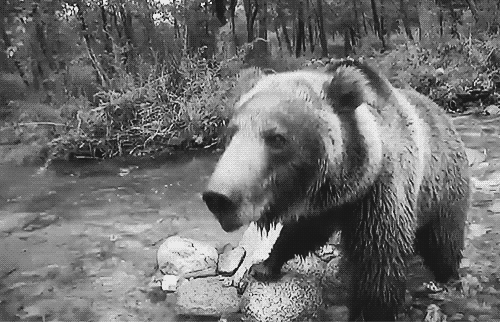
DISCLAIMER: I put the title and “werebeast” up there in quotation marks because I am an obsessive etymology scholar, historian, and folklorist who ultimately still kind of dislikes "were-” prefixes. Werewolves were the first “werebeasts” (calling them “weres” is calling them “men,” by the way) because that was the first and only time the term was used in relation to folklore. Modern popular culture started using “were-” to denote animal shapeshifters (which are, in themselves, often werewolves for all intents and purposes but happen to turn into a different kind of animal). So all these werebeasts owe everything they have in the modern era to werewolves.
Just saying!
(Another disclaimer: I like plenty of other shapeshifters, for the record. Rumors of my “hatred” for anything non-werewolf have been greatly exaggerated. Including bears. It’s just other people that have made me grouchy. I have had serious moments of wanting to turn a protagonist of my main novel series into a werebear, so don’t look at me that way. I love all shapeshifters and I do love bears.)
Anyway, with that briefly out of my system again, let’s get to the werebears.

(werebears are real, you guys)
Firstly, we must ask ourselves: what are they called if they aren’t called werebears? “Werebear” is a completely modern term derivative of “werewolf,” as mentioned above, so did bear shapeshifters have a particular name like all these names werewolves and vampires had?
The answer might disappoint you. Nope. They didn’t; sorry.
There were plenty of bear shapeshifters around, but they weren’t prevalent enough to get a particular name. You’ll find them called all sorts of things, depending on the language, but many of these terms haven’t really survived the test of time. Scholars usually refer to them simply as “bear shapeshifters,” or “bear men and bear women,” especially if they are of the non-shapeshifting variety (there are actually quite a few of those, as far as bears are concerned).
One of the few terms we might claim we have for werebears is Orsini (or Ursini, if you want to be less anglicized; it is, of course, derived from ursus, meaning bear). However, this term was used to refer not to shapeshifters, but to a stranger story.
In De Uniuerso, William of Auvergne (a Bishop of Paris) tells the story of a bear from Saxony who carried off a soldier’s wife. For years, the bear kept the woman in a cave and, ahem ahem, “knew” (that’s a direct quote) her “so that she bore him children.” She ran away and the kids went with her, turning into excellent soldiers. But they had faces similar to a bear’s (or “they had bear in their faces”). According to this bishop, the... ah... Tumblr will ban me if I use these terms. So, well, according to this guy, bears and humans could reproduce and this was the result. Let’s go with that.
No shapeshifting involved in this instance, though. There were, however, a gracious plenty of instances of bear shapeshifting. Let’s cover just a few.
First of all, like werewolves, bears get the whole “bear spirit” connection and lots of shamanistic magic and possession. Among the Sami people of Russia and Lapland, there were beliefs that shamans could be “possessed of the spirit of the bear” in order to acquire bear-like “attributes” and “behavior” and “strengths.” How you want to interpret those is up to you, since they weren’t more specific than that.
There were lots of shamanistic beliefs involving bears among other cultures, as well, including some Native American cultures. This involved either straight-up shapeshifting into a bear, or else acquiring “bear-like attributes” like before.

Then, of course, we have Old Norse myths involving bears, of which there were many. There were skins (belts, cloaks, etc) that could turn people into bears, much like the wolf-skin items from werewolf legends.
Then we have Bodvar Bjarki (”Warlike Little Bear”), a warrior who showed up in a lot of stories over time, including - but not limited to - Hrolfs Saga Kraka (the story of an early king of Denmark, who had Bodvar as a champion), Skjoldunga saga, and Getsa Danorum.
So who was Bodvar Bjarki? Well, he came from a long line of bear names, for starters. We should start with his dad, who was a werebear of sorts.
So his father was Bjorn (meaning “bear”), a guy who was turned into a bear by a witch. Bjorn could assume a human shape again during the night, when he was visited by a woman (Bera, meaning she-bear). They had three sons: one was half man and half elk, the second had the feet of a dog, and the third was Bodvar Bjarki.
In a later battle, all of Hrolf’s (that was the king Bodvar served, just to remind you) men were terribly outnumbered, until a massive bear came onto the battlefield and started fighting for them. He seemed immune to all weapons his foes put against him.
Bodvar, however, wasn’t there. He was sitting in his tent, completely motionless. When one of his friends bursts into his tent and berates him for not being at the battle, Bodvar wakes and tells him he can now do less for the king than if he’d not been interrupted.
So, as you might imagine, the bear disappeared as soon as Bodvar woke. Then they lost the battle. Good job, friend guy.
I will not, however, talk about berserkers here. I covered those in a werewolf fact! Read about berserkers here instead. Berserkers were not actually associated with bears, like so many scholars today want you to believe. That’s a totally new argument, though.
For the record, although lots of pop culture will try to tell you differently, there wasn’t really that much bear stuff in Norse myth. It was mostly wolves. There were also lots of boars, stags, hounds, even some bulls, but anything to do with bears was fewer and farther between.
Oh my gosh, this post is getting long, isn’t it? Let’s cover a few more things:
So what do modern pop culture werebears take from werebears of ye olden legends? There’s a good question. Here’s the answer:
Basically nothing.
Modern werebears are generally werewolves of a different skin. That’s how modern writers handle the overwhelming majority of all werecreatures, actually.
Want to be weird/different and take more from folklore werebears? It could actually be quite fun! One of the few bear shapeshifter stories we have is the one mentioned above, where Bjorn turns into a human at night instead of during the day, like some werewolves do. Just saying.
Overall, though, I think that covers a good amount of werebear things for now. If enough people are interested, I can always do a werebears part 2.
For now, though, let’s just take a moment to appreciate all things bear.
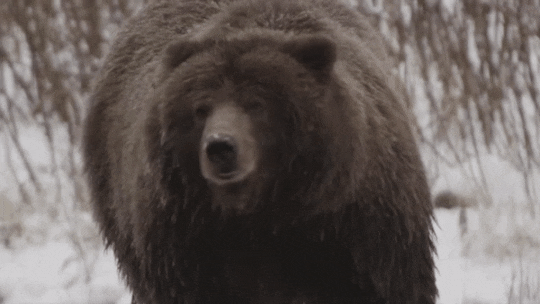
#folklore#folklore facts#werebear#werebears#werebeasts#weres#lycanthropes#lycanthropy#Norse mythology#shapeshifters#shapeshifting#shifters#bears#berserkers#folklore thursday#folklorethursday#werecreatures#yes i seriously considered turning Caiden into a werebear for real#I can't promise I won't#it's unlikely but
147 notes
·
View notes
Text
“The Cosmic Hunt” -- 15,000-year-old prehistoric mythology and astronomy-themed folklore from deep in the Ice Age demonstrates the importance of story-telling and indigenous knowledge in understanding human origins
The study of mythology and folklore is extremely important to understanding the deep ancient history of human land-use, expansion, genetics, and cultural development. Perhaps the most famous example of mythology as a utility for understanding the human past is the “Cosmic Hunt” myth. This myth is one of the single most important human stories in all of existence, because our knowledge of this story has huge ramifications for our understanding of human migration, the prehistoric human lifestyle, human environmental adaptation, and the interconnectivity of human cultures.
The Cosmic Hunt is a mythological narrative wherein some human characters are hunting a large mammal as prey - often a horned herbivore or a bear - and shenanigans ensue wherein an ungrateful human character becomes imprisoned in the sky. The myth relies on astronomical knowledge of stellar constellations; when story-tellers acted-out the story, they pointed to constellations to represent characters. The humans and animals in the story are represented most often by Cassipoeia, Orion, Ursa Major, and the Pleiades.
The myth is found among such dramatically different cultures as Siberian Urgic peoples; Sami reindeer herders; Iroquois and Ojibwa of the Great Lakes; Snohomish Salish in the Pacific Northwest; Indo-European people in India; prehistoric Europe; Iranian peoples in the Middle East; Tuareg in North Africa; and cultures of sub-Saharan Africa.
How ancient is this mythology?
The Cosmic Hunt narrative is just about the oldest human myth that modern scholars have been able to catalogue, a narrative that is recognizable as early in prehistory as 12,000-to-17,000 years ago, long before “civilization” and sedentary agriculture. The myth existed thousands of years before the end of the latest Ice Age of the Pleistocene.
The myth is so old, that it exists among both proto-Indo-European peoples of Eurasia and sub-Saharan peoples in central Africa, and also among Native American cultures who carried the story with them across the Bering land bridge. The land bridge disappeared over 12,000 years ago, meaning the myth is at least as old; It’s even possible that the myth existed and crossed into North America 20,000 to 25,000 years ago.
This myth is so old, that we’re talking 10,000 years before the existence of Ancient Egyptian civilization.
We’re talking thousands of years before the Pleistocene megafauna like mammoths and cave bear and sabre-toothed cats went extinct.
The myth exists in similar form among Tuareg of the Sahara, Kurds in Iran and the Fertile Crescent, nomadic peoples in Central Asia, shamans in Siberia, the Coast Salish of the Pacific Northwest, and Iroquois peoples of the Great Lakes.
The reason that the constellation Ursa Major is associated with bears is probably because of this myth.
-
Here’s how Julien d’Huy, one of the most prominent scholars of the Cosmic Hunt, summarizes the myth:
As the Iroquois of the northeastern U.S. tell it, three hunters pursue a bear; the blood of the wounded animal colors the leaves of the autumnal forest. The bear then climbs a mountain and leaps into the sky. The hunters and the animal become the constellation Ursa Major. Among the Chukchi, a Siberian people, the constellation Orion is a hunter who pursues a reindeer, Cassiopeia. Among the Finno-Ugric tribes of Siberia, the pursued animal is an elk and takes the form of Ursa Major.
-
Ursa Major, an important constellation in many Cosmic Hunt variations:

A 6,000-year-old cave drawing from Spain, probably depicting Cosmic Hunt iconography:

-
Now, check this out:
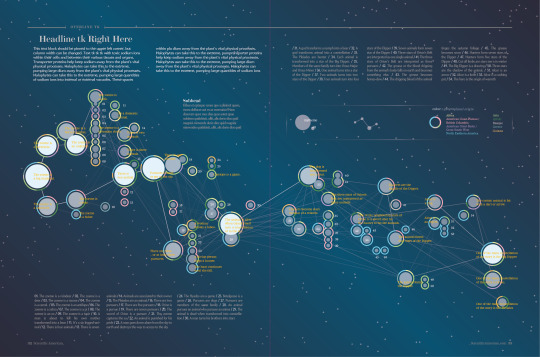
OK, take deep breath.
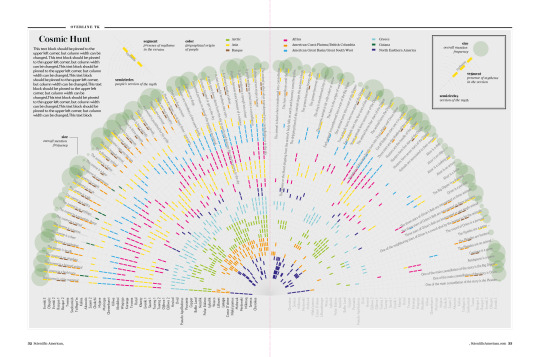
If nothing else comes from my monologuing, then please go visit these two diagrams to see them in their high-resolution forms.
These diagrams are what I call “the ultimate depictions of the Cosmic Hunt.” The first was made by Accurat Studio and was solicited by Scientific American, who wanted a graphic that encapsulated all of the wonderful data analyzed by the groundbreaking research of d’Huy as published in d’Huy’s definitive article on the Cosmic Hunt (referenced below in this post). I highly recommend checking-out the high-resolution version of this map, because it indicates not just which diverse cultures had a version of the myth and the trajectory by which the story spread from culture to culture, but the map also indicates which details change in the story (for example, whether or not one of the human characters gets killed, what kind of animal they’re hunting, etc.)
The second diagram was also made by Scientific American, and contains even more information, and depicts pretty much every variation in the story (How many hunters were there? Were they accompanied by a dog? What were they hunting? Which constellations are involved?) Find it here.
-
Look at how widespread this myth is!
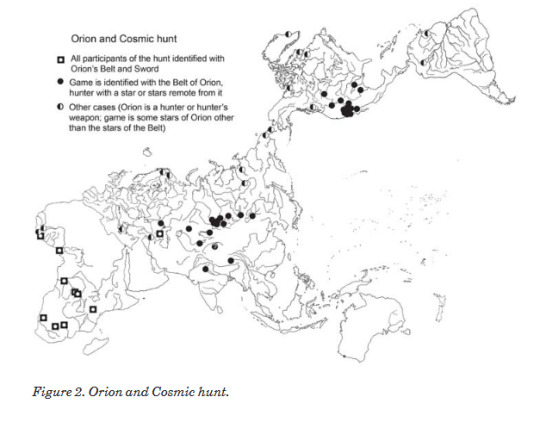
This map is just one of the many maps of the wide distribution of the Cosmic Hunt that Yuri Berezkin has made. The map shows distribution of just one variation of the myth. Check-out maps of other variations of the myth in this Berezkin’s article.
Here’s another look at some of the cultures where the Cosmic Hunt myth existed in its first- and second-oldest known variants, wherein the Big Dipper represents three hunters and their dog. In sites labelled “1″ - the three stars of the handle are hunters, and the dipper is an animal. In sites labelled “2″ - Alcor is a cooking pot. In sites labelled “3″ - either Orion’s Head or Betelgeuse represent the hunter’s arrow. (Source.)
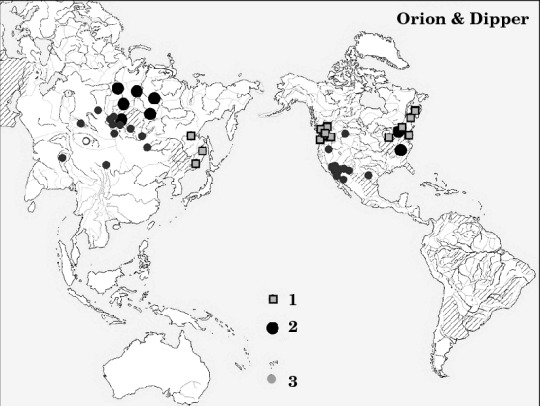
Here’s a different variation of the Cosmic Hunt. The hunter is embodied by the constellation Orion and the hunted animal represented by either Pleiades or Cassiopeia. In these tales, the hunted animal is considered to be a bear. However, this map is not comprehensive. Most variations of the myth actually involve the hunting of an ungulate; these stories are more common in North Africa and the Middle East. (Map source.)
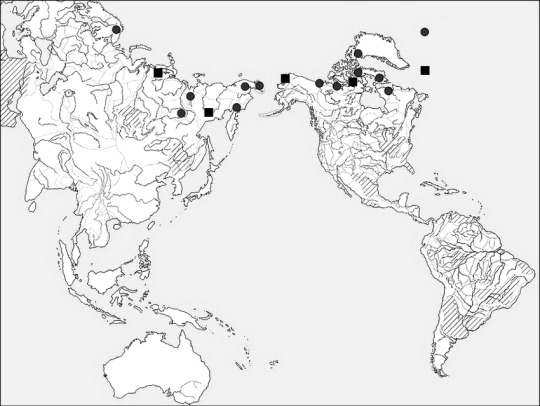
-
What important information does this myth tell us?
Early humans had sophisticated knowledge of astronomy.
The myth uses stellar constellations, especially Ursa Major, to tell the story of human hunters pursuing a large mammal. The mammal being hunted is most often a large horned herbivore or ungulate, but a significant amount of cultures depict the animal as a bear.
Among archaeoastronomy scholars and anthropologists, the Cosmic Hunt is also notable because it demonstrates that early humans maintained sophisticated and accurate knowledge of astronomy.
“Civilization,” sedentary agriculture, and commercialism are not essential to creating long-lasting cultures with sophisticated environmental knowledge, which is often story told in Western history books.
The myth is important to understanding early human migration and settlement.
Though most iterations of the story involve the chasing of a bear, some lineages of the story depict the hunted animal as a large horned herbivore or ungulate. It is these regional variations and minor differences in the story that allow scholars to reconstruct how the myth spread and therefore determine the age of each change in the story.
The ability to date the story via small changes in the narrative means that multidisciplinary researchers can also reinforce our understanding of the timeline of early human expansion across Eurasia and into North America.
Indigenous knowledge isn’t just an encyclopedia of environmental knowledge; indigenous knowledge also preserves historical information.
The reconstruction of the Cosmic Hunt myth and its history of transmission would not have been possible if various indigenous cultures had been assimilated by dominant imperial and colonialist powers. We only know about the majority of the Cosmic Hunt variations because they were kept alive by story-telling among the Sami, the Salish, the Objibwa, and other indigenous cultures. Had these cultures been further decimated by imperial powers, we probably wouldn’t have realized how important the Cosmic Hunt story is, and we wouldn’t have known about the sequence of historical transmission of the story.
Linguistic research is extremely valuable, and language is incredibly important.
Linguists are fascinated with the Cosmic Hunt because it demonstrates the utility of language and stories in deducing the age of cultural connections between apparently distinct cultures. We have our current knowledge of the Cosmic Hunt and its historic sharing across cultures specifically because different languages adapted similar terminology to name features and characters in the story. Linguistic analysis is what gives us our knowledge of the Cosmic Hunt.
Why is the Cosmic Hunt so important for multiple scientific disciplines?
The myth is routinely re-evaluated by researchers, who continue to repeatedly confirm its truly ancient origin in the Paleolithic era.
Why do so many scholars value the Cosmic Hunt? Here’s what a prominent scholar of the myth - Julien d’Huy - had to say in a recent analysis:
“Our phylogenetic approach of myths allows us to: 1/ confirm the Paleolithic datation of the Cosmic Hunt linked to a horned herbivore, 2/ reconstruct the first version of the myth, 3/ corroborate the hypothesis of a Europen post-glacial human recolonization of Europe and a part of North Africa from the Franco-Cantabrian refuge, 4/ prove the existence of a mythological root common to Berbers and European hunter-gatherers. 6/ document at least four migrations from Eurasia into America and suggest that there was reverse migration from Eurasia to Africa, 5/ find support for the punctuated evolution of myths, 6/ offer some suggestions to interpret prehistoric rock art images that should be discovered. Thus, the study of human mythology directly opens up new ways for genetics, archaeology and rock art researches.”
This passage was taken from one of the very best analyses ever made on the Cosmic Hunt myth and its spread among prehistoric cultures, a peer-reviewed article by researcher Julien d’Huy named “A Cosmic Hunt in the Berber sky: a Phylogenetic Reconstruction of a Paleolithic Mythology.” Below, I’ll share some of the best graphics and diagrams to come out of this study.
-
Here is an example of how studying the minor variations and changes in the details of the myth can help us determine the age of the story and the trajectory of how it spread from one culture to the next. This is a helpful visualization of how the story changed over time:
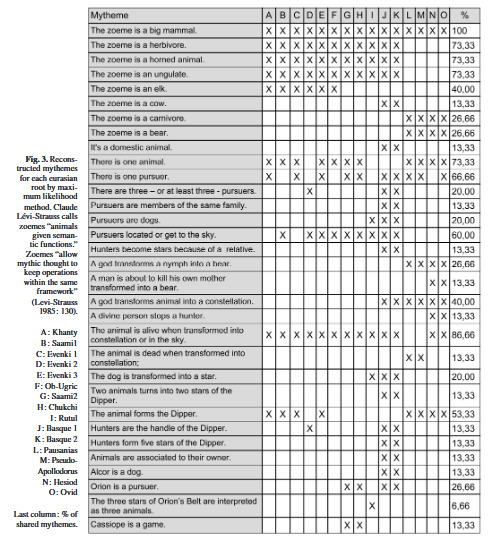
This diagram is the result of decades of evaluation of the Cosmic Hunt myth-motif. Taking cues from this diagram, we can make some observations, for example: the most common variation of the myth among about 74% of cultures involves a horned herbivore. In about 27% of cultures, the animal being hunted is a bear; we can begin to deduce that those cultures.
-
Here’s a look at the spread of the myth among Native American cultures (use this link to access the high-resolution version):
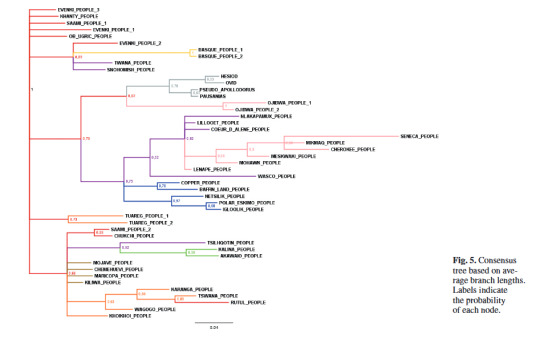
-
Here’s Orion the Hunter, and Taurus, in an illustration from Johann Bode’s Uranographia (1901).

So, story-telling is important. Scholarship on the Cosmic Hunt has given us incredible information about human migration, expansion, and early knowledge.
Ever wonder why Orion is depicted as a hunter and what his beef is (no pun intended) with Taurus? Regardless of the constellation’s association with Greco-Roman tradition, this is another manifestation of the Paloelithic Cosmic Hunt motifs. The Orion constellation was central to many variations of the Cosmic Hunt. Orion remains the protagonist hunter, and Taurus is the representation of the “large horned herbivore” that at the center of the story.
In other words, a 15,000-year-old folk tale predating civilization and created in the midst of mammoths is still fully intact and alive in modern culture and story-telling.
31 notes
·
View notes
Note
I think that you have to be careful when deciding what’s myth and what’s not. Especially in regards to Native American, African, and Oceanic cultures, the label of “myth” was historically slapped onto stories that present-day tribes and people still consider sacred, spiritual, and even religious. Wouldn’t creating fanfiction out of the cultural beliefs of underrepresented groups be considered cultural appropriation? Are the mods going to take special precaution to prevent that?
Please refer to our updated response here!
Hello!!
Apologies for the delay in response, we’ve been discussing this for quite some time and have come to several conclusions. We have been in contact with someone who is very well versed in this topic, especially in regards to writing about and of such cultures and their history.
Throughout our discussion, we have learned potential ways to go about doing such a thing, one of which was race-bending. However, doing race-bending properly is rather difficult and can do wrong quite easily, and so we prefer not to include this option for the safety of other cultures and people from those cultures.
We have, through this person’s detailed advice, removed African, North American and Oceanic mythologies from our list, instead only European (except for minority cultures - for example, the Sami in Finland) and Asian (except for Korean and Chinese mythology, looking at the history between those two countries and Japan you can see it hasn’t been the best.) mythology.
We have addressed and explain this in detail here.
Now, we are aware that there have been some individuals who have contacted blogs that teach and provide resources on writing different cultures, different races and ethnic groups as well. We do appreciate your efforts to protect and reduce the risk of cultural appropriation, however we kindly ask you do not do such things again. If you have, please do tell us about doing so. For now, please let us handle such things.
We have addressed a blog that has received asks about our zine in particular, and the mod has stated that such future asks will be deleted.
Please contact us about our own content, if you have concerns, we will address them to the best of our ability. If we are stuck, we will look to outward help to teach and inform us of the best course of action.
Thank you!!
- BNHA Myths Zine Mods
#asks#replies#zine mods#anon#please do /tell/ us if you have addressed another blog about this.#we can easily learn from responses that are shared with us. and by not addressing other blogs you can come to us any time and we will take#necessary actions
9 notes
·
View notes
Photo
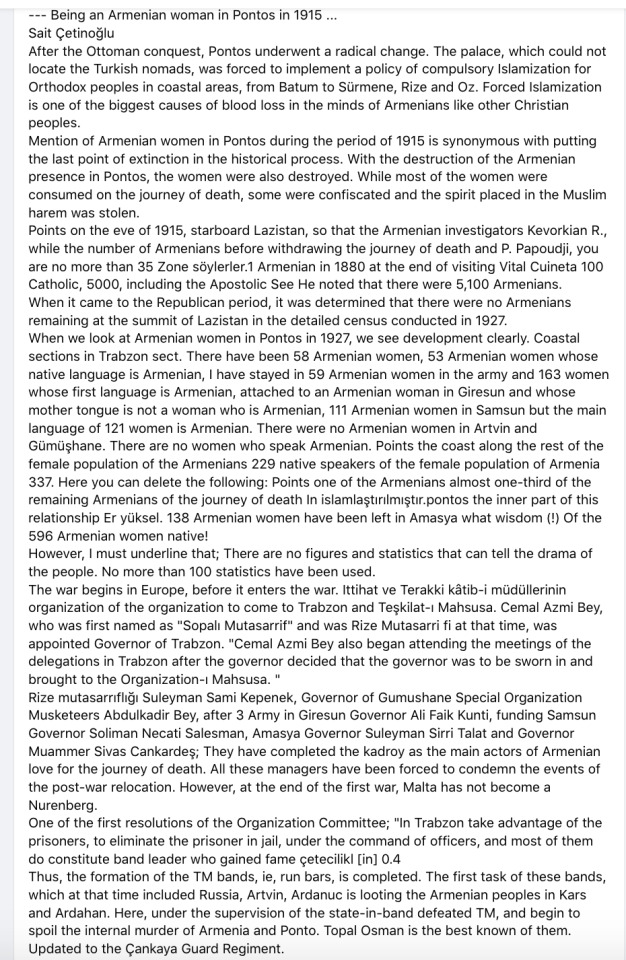

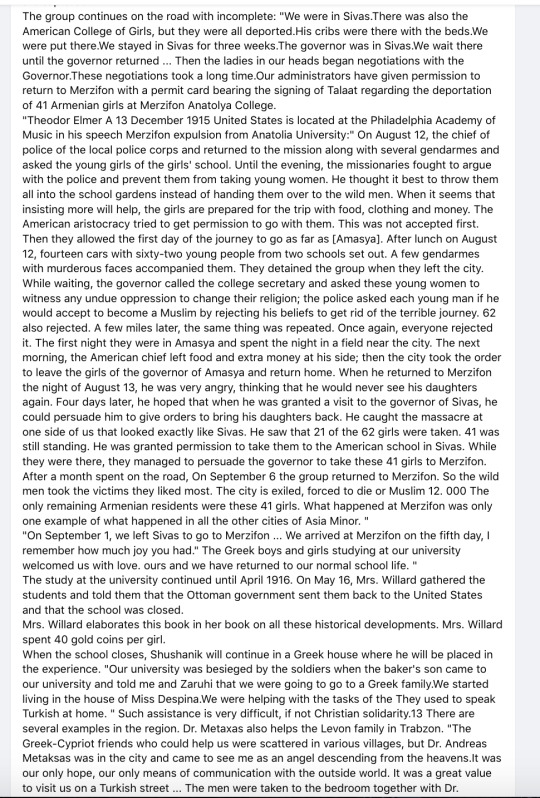
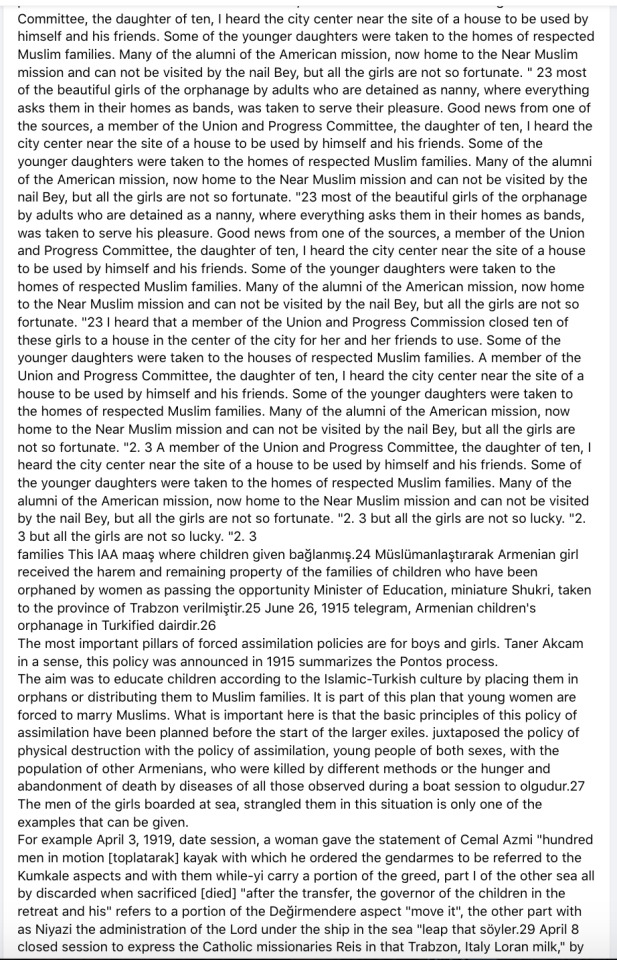

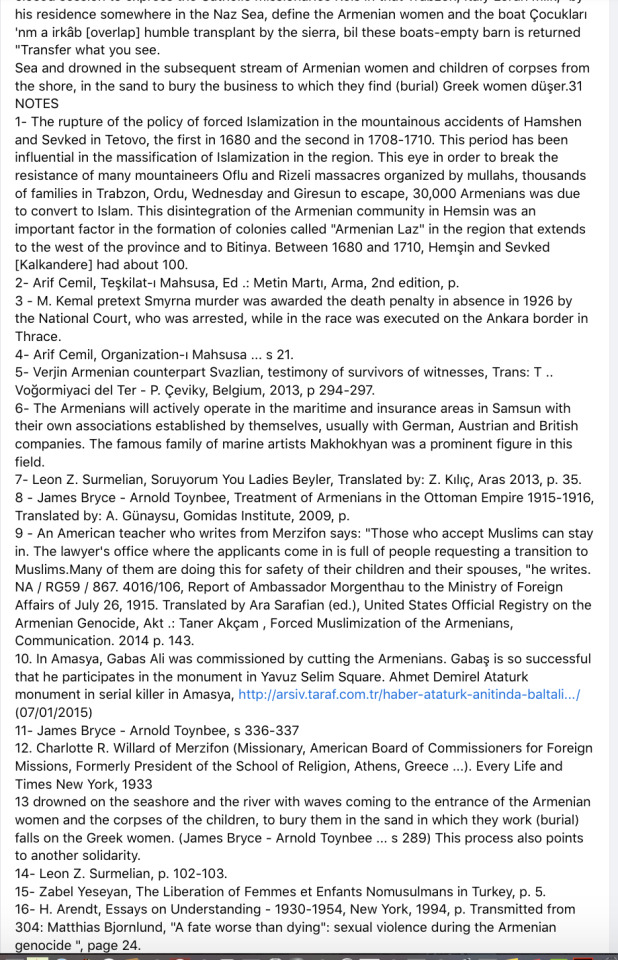
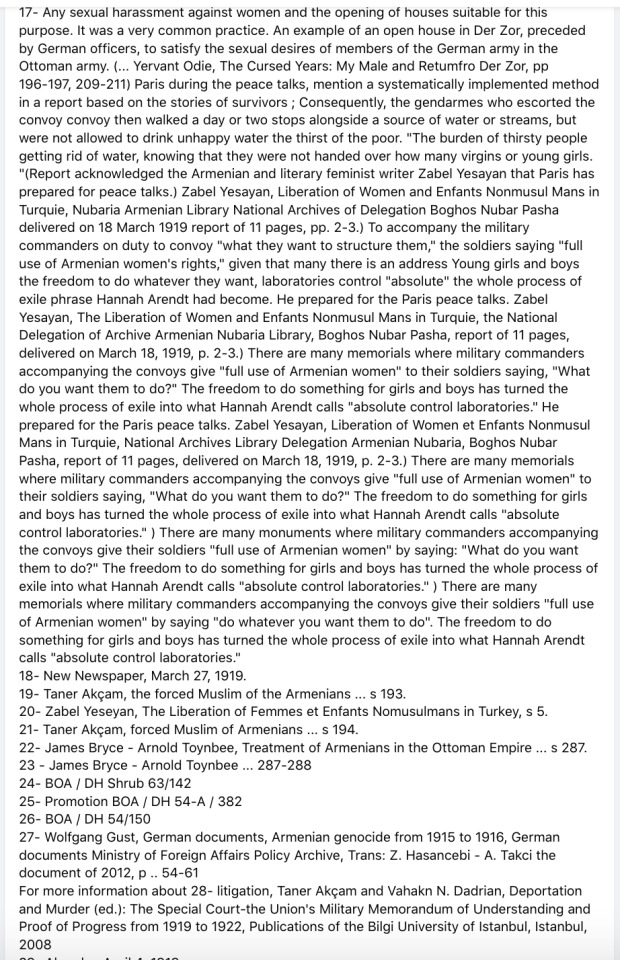
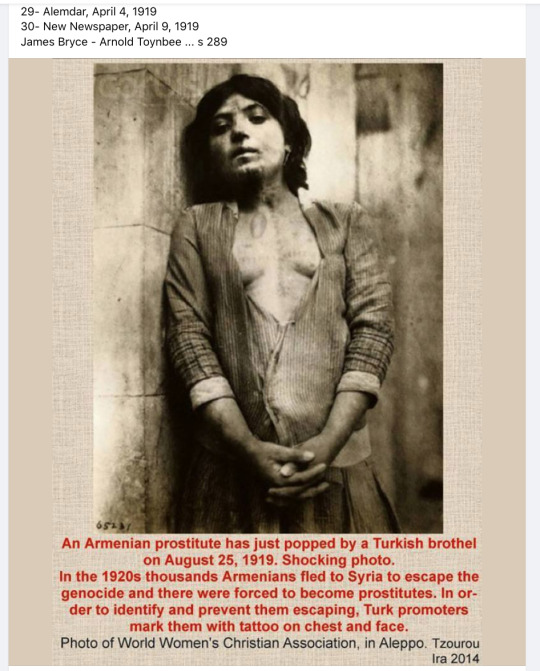
https://www.facebook.com/miguelangel.nalpatian/posts/10215183537088790
.
https://yakindoguyazilari.com/sait-cetinoglu-1915-soykirim-surecinde-ermeni-gen-havuzuna-el-konmasi-ve-seks-koleligi/
..
--- Being an Armenian woman in Pontos in 1915 ...Sait ÇetinoğluAfter the Ottoman conquest, Pontos underwent a radical change. The palace, which could not locate the Turkish nomads, was forced to implement a policy of compulsory Islamization for Orthodox peoples in coastal areas, from Batum to Sürmene, Rize and Oz. Forced Islamization is one of the biggest causes of blood loss in the minds of Armenians like other Christian peoples.Mention of Armenian women in Pontos during the period of 1915 is synonymous with putting the last point of extinction in the historical process. With the destruction of the Armenian presence in Pontos, the women were also destroyed. While most of the women were consumed on the journey of death, some were confiscated and the spirit placed in the Muslim harem was stolen.Points on the eve of 1915, starboard Lazistan, so that the Armenian investigators Kevorkian R., while the number of Armenians before withdrawing the journey of death and P. Papoudji, you are no more than 35 Zone söylerler.1 Armenian in 1880 at the end of visiting Vital Cuineta 100 Catholic, 5000, including the Apostolic See He noted that there were 5,100 Armenians.When it came to the Republican period, it was determined that there were no Armenians remaining at the summit of Lazistan in the detailed census conducted in 1927.When we look at Armenian women in Pontos in 1927, we see development clearly. Coastal sections in Trabzon sect. There have been 58 Armenian women, 53 Armenian women whose native language is Armenian, I have stayed in 59 Armenian women in the army and 163 women whose first language is Armenian, attached to an Armenian woman in Giresun and whose mother tongue is not a woman who is Armenian, 111 Armenian women in Samsun but the main language of 121 women is Armenian. There were no Armenian women in Artvin and Gümüşhane. There are no women who speak Armenian. Points the coast along the rest of the female population of the Armenians 229 native speakers of the female population of Armenia 337. Here you can delete the following: Points one of the Armenians almost one-third of the remaining Armenians of the journey of death In islamlaştırılmıştır.pontos the inner part of this relationship Er yüksel. 138 Armenian women have been left in Amasya what wisdom (!) Of the 596 Armenian women native!However, I must underline that; There are no figures and statistics that can tell the drama of the people. No more than 100 statistics have been used.The war begins in Europe, before it enters the war. Ittihat ve Terakki kâtib-i müdüllerinin organization of the organization to come to Trabzon and Teşkilat-ı Mahsusa. Cemal Azmi Bey, who was first named as "Sopalı Mutasarrif" and was Rize Mutasarri fi at that time, was appointed Governor of Trabzon. "Cemal Azmi Bey also began attending the meetings of the delegations in Trabzon after the governor decided that the governor was to be sworn in and brought to the Organization-ı Mahsusa. "Rize mutasarrıflığı Suleyman Sami Kepenek, Governor of Gumushane Special Organization Musketeers Abdulkadir Bey, after 3 Army in Giresun Governor Ali Faik Kunti, funding Samsun Governor Soliman Necati Salesman, Amasya Governor Suleyman Sirri Talat and Governor Muammer Sivas Cankardeş; They have completed the kadroy as the main actors of Armenian love for the journey of death. All these managers have been forced to condemn the events of the post-war relocation. However, at the end of the first war, Malta has not become a Nurenberg.One of the first resolutions of the Organization Committee; "In Trabzon take advantage of the prisoners, to eliminate the prisoner in jail, under the command of officers, and most of them do constitute band leader who gained fame çetecilikl [in] 0.4Thus, the formation of the TM bands, ie, run bars, is completed. The first task of these bands, which at that time included Russia, Artvin, Ardanuc is looting the Armenian peoples in Kars and Ardahan. Here, under the supervision of the state-in-band defeated TM, and begin to spoil the internal murder of Armenia and Ponto. Topal Osman is the best known of them. Updated to the Çankaya Guard Regiment.It is maintained in 1915 in the match process live 1901 Trabzon born Şuşanik Hovhannes Paçacı who conveys the tragic journey of the darkness of Merzifon'un in the period 1915: 5 "My father Hovhannes had a married sister and seven brothers and Onika Makhokhy Onik Makhokhyan was the elder brother of the painter Vardan Makhokhyan, whose parents were wealthy people and had a good education for their children.When I am still engaged, I married until I was hired to teach a special French governess to her who had taken her home of the piano to learn to play the piano, only then came to the houses on the roof. "The words point to the cultural level of Points. Surmelian of 1905 the writer born in Trabzon Leo A Zaven "I ask you ladies and gentlemen," the autobiography entitled " We were asked the children to demonstrate our abilities. Piano nivart Onnig stole the violin ... "7 The words are in the routine life of the period.The piano is a familiar part of the life of a middle-class family with Pontos.Based on the Bucharest correspondent of the times , witnessed a piano that was confiscated to the Armenians in Trabzon news that London now writes 10-15 cents bulduğunu receiver 8. In those days, opened a 5-dish on the market. witnessed a piano that was confiscated from the Armenians in Trabzon news that London now writes 10-15 cents receiver bulduğunu8. In those days, a plate 5 was opened in the market. witnessed a piano that was confiscated from the Armenians in Trabzon news that London now writes 10-15 cents receiver bulduğunu8. In those days, a plate 5 was opened in the market.In Merzifon, the Armenians were initially invited to Islam:"The two Gulyan daughters of our university, Armine and Hiranush, graduated from Anatolian College, and Armine, who was older than the girls, taught me mathematics in the third grade." Before the devastation, he was forced to change his religion On the contrary, they were not put back and that the girl, her family outside, brother of beech, her husband, the wife of his brother and Hasmik and Lutfik is two Armenian students were captured typhus when Svazlian who taught life has the kurtardı.9 College and could not be saved.It was buried in the Muslim funeral Muslim cemetery.â € The rest of the relocation if all the teachers, we learn who died of Şuşanik.Shushanik's trip begins at Merchifon on August 12: "I went to the American house from the age of four, and then I studied at Merzifon Anadolu Koleji where Miss Charlotte Willard was the principal.When the relocation began in 1915, people in our university we were deported.We were with our teachers.All of us were deported in fifteen cars.No one knew where we were.We passed the banks from the hans to Amasya.We were put in two small rooms on the second floor of a building to sleep there ". The exiles can not sleep through the night with the screams and the heartbreaking cries of people. "Mrs. Willard is with students to Amasya. He will be returned from Amasya. However, Mrs. Willard and her deputy, Ms. Cage, sent letters to the US ambassador in the Ottoman state, Morgenthau, and were allowed not to expel the students in their schools. This permission can not be communicated to the governor of Turhal, the students arrive at the Sivas convoy with trips with difficulties:Especially our municipality told us that travel expenses were paid in full. When the caravan and the gendarmerie saw that they were not paying for themselves, they continued on the road, threatening to leave us at the next stop. This way we get to Yenihan and leave the entrance. They gave us an empty room; but the guards at the door did not allow anyone to leave even if they did not get the money, even to get rid of their natural needs. That night, the armed guards made a lot of money. " but the guards at the door did not allow anyone to leave even if they did not get the money, even to get rid of their natural needs. That night, the armed guards made a lot of money. " but the guards at the door did not allow anyone to leave even if they did not get the money, even to get rid of their natural needs. That night, the armed guards made a lot of money. "Those who follow the daughters of the girls, confiscate what they have cut:"Şükrü Bey follows us from Amasya, because she liked one of our teachers and persecuted him, finally followed us until we finally had and we take him as wife." 21 In this way, children are captured.The group continues on the road with incomplete: "We were in Sivas.There was also the American College of Girls, but they were all deported.His cribs were there with the beds.We were put there.We stayed in Sivas for three weeks.The governor was in Sivas.We wait there until the governor returned ... Then the ladies in our heads began negotiations with the Governor.These negotiations took a long time.Our administrators have given permission to return to Merzifon with a permit card bearing the signing of Talaat regarding the deportation of 41 Armenian girls at Merzifon Anatolya College."Theodor Elmer A 13 December 1915 United States is located at the Philadelphia Academy of Music in his speech Merzifon expulsion from Anatolia University:" On August 12, the chief of police of the local police corps and returned to the mission along with several gendarmes and asked the young girls of the girls' school. Until the evening, the missionaries fought to argue with the police and prevent them from taking young women. He thought it best to throw them all into the school gardens instead of handing them over to the wild men. When it seems that insisting more will help, the girls are prepared for the trip with food, clothing and money. The American aristocracy tried to get permission to go with them. This was not accepted first. Then they allowed the first day of the journey to go as far as [Amasya]. After lunch on August 12, fourteen cars with sixty-two young people from two schools set out. A few gendarmes with murderous faces accompanied them. They detained the group when they left the city. While waiting, the governor called the college secretary and asked these young women to witness any undue oppression to change their religion; the police asked each young man if he would accept to become a Muslim by rejecting his beliefs to get rid of the terrible journey. 62 also rejected. A few miles later, the same thing was repeated. Once again, everyone rejected it. The first night they were in Amasya and spent the night in a field near the city. The next morning, the American chief left food and extra money at his side; then the city took the order to leave the girls of the governor of Amasya and return home. When he returned to Merzifon the night of August 13, he was very angry, thinking that he would never see his daughters again. Four days later, he hoped that when he was granted a visit to the governor of Sivas, he could persuade him to give orders to bring his daughters back. He caught the massacre at one side of us that looked exactly like Sivas. He saw that 21 of the 62 girls were taken. 41 was still standing. He was granted permission to take them to the American school in Sivas. While they were there, they managed to persuade the governor to take these 41 girls to Merzifon. After a month spent on the road, On September 6 the group returned to Merzifon. So the wild men took the victims they liked most. The city is exiled, forced to die or Muslim 12. 000 The only remaining Armenian residents were these 41 girls. What happened at Merzifon was only one example of what happened in all the other cities of Asia Minor. ""On September 1, we left Sivas to go to Merzifon ... We arrived at Merzifon on the fifth day, I remember how much joy you had." The Greek boys and girls studying at our university welcomed us with love. ours and we have returned to our normal school life. "The study at the university continued until April 1916. On May 16, Mrs. Willard gathered the students and told them that the Ottoman government sent them back to the United States and that the school was closed.Mrs. Willard elaborates this book in her book on all these historical developments. Mrs. Willard spent 40 gold coins per girl.When the school closes, Shushanik will continue in a Greek house where he will be placed in the experience. "Our university was besieged by the soldiers when the baker's son came to our university and told me and Zaruhi that we were going to go to a Greek family.We started living in the house of Miss Despina.We were helping with the tasks of the They used to speak Turkish at home. " Such assistance is very difficult, if not Christian solidarity.13 There are several examples in the region. Dr. Metaxas also helps the Levon family in Trabzon. "The Greek-Cypriot friends who could help us were scattered in various villages, but Dr. Andreas Metaksas was in the city and came to see me as an angel descending from the heavens.It was our only hope, our only means of communication with the outside world. It was a great value to visit us on a Turkish street ... The men were taken to the bedroom together with Dr. Metaksas for a new meeting; where one of the boys was immediately sent to the Greek monastery where he sent the family of the Doctor. In the Wild Pontus Mountains, this monastery, which is everywhere, was an ideal place to hide an Armenian. The name of the monastery was Sumela ... Onnig dressed like a Greek villager and went to the monastery with a Greek mule. Thank God, our unity has survived. If we all die, Onnig will keep his family name. "14 He dressed like a Greek villager and went to the monastery with a Greek mule.Thanks to God, our unity has survived.If we all die, Onnig will keep his family name." 14 He dressed like a Greek villager and went to the monastery with a Greek mule. Thank God, our unity has survived. If we all die, Onnig will keep his family name. "Armenian breakthroughs in road deaths, Şuşanik Muslim women stayed home to entertain! "High-ranking come to visit their partners in the official Ottoman gold jewelry, they were playing the lute and singing ... I only take piano lessons at university and they succeeded, and often accompanied by the piano of their songs, but the nation my agony when, myself who had to engage in entertainment that reckless women felt so bad.The political situation changed when, in 1918, we were taken back from families and boarding schools were reopened Greek but this took a little time. " This time, the Central Army commander, Sakalli Nurettin Pasha College, shuts down not to open any more.But not everyone is as lucky as Shushanik. Trabzon, the switch girls raped about 8-10 years, and then killed; 15 exile and destruction to participate in several high-level executives to establish their harems and sexual party organization almost a common place uygulamalardır.16 example, the Red Crescent Hospital in Trabzon Governor Cemal Azmi these and other officials of the girls young people are sexual objects such as those used by an entertainment center dönüştürülmüştü.17 trial Trabzon came to the agenda of the March 26 meeting and the judge, the accused and witnesses of events in that knowledge başvurmuştur.18 that, to be presented as gifts to each of the young girls are extremely common was a practice"Inclusion should last for a period, it is sexual harassment carried out against women and children, the only possible explanation being that some people will be satisfied with their pleasure." Armenian woman as author As Zabel Yeseyan justify these crimes, according to certain rules and ordered manner is processed and the Armenian nation of humiliation for the purpose yapılmaktadır.20 women and girls of the body to the Armenian attack, which is considered as playing with the dignity of the nation and crimes of perpetrators, "occupation of an area belonging to the enemy nation ".The US ambassador, Henry Morgenthau, the United States consul in Trabzon sent the Ministry of Foreign Affairs on July 29, 1915 Oscar S. Heizer July 28, 1915 Date report on women and given to inhumane practices against "According to a credible eyewitness, Armenia Boghos, a wealthy and respectable Marimy and his two sons were murdered in lined up in a row. The wife and daughter of an Armenian named Arts back had been handed over to the gendarmes who were killed after being raped by gendarmerie agents.The head of a child was hit by a rock and then his brain was expelled.All the men were killed,not a single person in the 45-person group survived. "22US Consul, but also the children of the Armenian Muslim orphanages testify to distribute the Efrat band. "The placement of children in schools or orphanages, founded by the archbishop and supported, presided by the governor, his deputy patriarch of the president, three Muslims and taken under the supervision of the committee formed by three Christian members and the closure of the orphanage and the children that is distributed in this way for us, and was a great disappointment for the Greek archbishop.The Greek archbishop had worked much on this occasion and had obtained the support of the governor.But the local leader of the Union and Progress Committee, Nail Bey, opposed this plan, and in a short time had managed to block the application. Many small child to be distributed to farmers [Platane Pulathan to Akcaabat] sent. most of the beautiful girls of the orphanage by adults who are detained as nanny, where everything asks them in their homes as bands, was taken to serve their pleasure. Good news from one of the sources, a member of the Union and Progress Committee, the daughter of ten, I heard the city center near the site of a house to be used by himself and his friends. Some of the younger daughters were taken to the homes of respected Muslim families. Many of the alumni of the American mission, now home to the Near Muslim mission and can not be visited by the nail Bey, but all the girls are not so fortunate. " 23 most of the beautiful girls of the orphanage by adults who are detained as nanny, where everything asks them in their homes as bands, was taken to serve their pleasure. Good news from one of the sources, a member of the Union and Progress Committee, the daughter of ten, I heard the city center near the site of a house to be used by himself and his friends. Some of the younger daughters were taken to the homes of respected Muslim families. Many of the alumni of the American mission, now home to the Near Muslim mission and can not be visited by the nail Bey, but all the girls are not so fortunate. "23 most of the beautiful girls of the orphanage by adults who are detained as a nanny, where everything asks them in their homes as bands, was taken to serve his pleasure. Good news from one of the sources, a member of the Union and Progress Committee, the daughter of ten, I heard the city center near the site of a house to be used by himself and his friends. Some of the younger daughters were taken to the homes of respected Muslim families. Many of the alumni of the American mission, now home to the Near Muslim mission and can not be visited by the nail Bey, but all the girls are not so fortunate. "23 I heard that a member of the Union and Progress Commission closed ten of these girls to a house in the center of the city for her and her friends to use. Some of the younger daughters were taken to the houses of respected Muslim families. A member of the Union and Progress Committee, the daughter of ten, I heard the city center near the site of a house to be used by himself and his friends. Some of the younger daughters were taken to the homes of respected Muslim families. Many of the alumni of the American mission, now home to the Near Muslim mission and can not be visited by the nail Bey, but all the girls are not so fortunate. "2. 3 A member of the Union and Progress Committee, the daughter of ten, I heard the city center near the site of a house to be used by himself and his friends. Some of the younger daughters were taken to the homes of respected Muslim families. Many of the alumni of the American mission, now home to the Near Muslim mission and can not be visited by the nail Bey, but all the girls are not so fortunate. "2. 3 but all the girls are not so lucky. "2. 3 but all the girls are not so lucky. "2. 3families This lAA maaş where children given bağlanmış.24 Müslümanlaştırarak Armenian girl received the harem and remaining property of the families of children who have been orphaned by women as passing the opportunity Minister of Education, miniature Shukri, taken to the province of Trabzon verilmiştir.25 June 26, 1915 telegram, Armenian children's orphanage in Turkified dairdir.26The most important pillars of forced assimilation policies are for boys and girls. Taner Akcam in a sense, this policy was announced in 1915 summarizes the Pontos process.The aim was to educate children according to the Islamic-Turkish culture by placing them in orphans or distributing them to Muslim families. It is part of this plan that young women are forced to marry Muslims. What is important here is that the basic principles of this policy of assimilation have been planned before the start of the larger exiles. juxtaposed the policy of physical destruction with the policy of assimilation, young people of both sexes, with the population of other Armenians, who were killed by different methods or the hunger and abandonment of death by diseases of all those observed during a boat session to olgudur.27 The men of the girls boarded at sea, strangled them in this situation is only one of the examples that can be given.For example April 3, 1919, date session, a woman gave the statement of Cemal Azmi "hundred men in motion [toplatarak] kayak with which he ordered the gendarmes to be referred to the Kumkale aspects and with them while-yi carry a portion of the greed, part I of the other sea all by discarded when sacrificed [died] "after the transfer, the governor of the children in the retreat and his" refers to a portion of the Değirmendere aspect "move it", the other part with as Niyazi the administration of the Lord under the ship in the sea "leap that söyler.29 April 8 closed session to express the Catholic missionaries Reis in that Trabzon, Italy Loran milk," by his residence somewhere in the Naz Sea, define the Armenian women and the boat Çocukları 'nm a irkâb [overlap] humble transplant by the sierra, bil these boats-empty barn is returned "Transfer what you see.Sea and drowned in the subsequent stream of Armenian women and children of corpses from the shore, in the sand to bury the business to which they find (burial) Greek women düşer.31NOTES1- The rupture of the policy of forced Islamization in the mountainous accidents of Hamshen and Sevked in Tetovo, the first in 1680 and the second in 1708-1710. This period has been influential in the massification of Islamization in the region. This eye in order to break the resistance of many mountaineers Oflu and Rizeli massacres organized by mullahs, thousands of families in Trabzon, Ordu, Wednesday and Giresun to escape, 30,000 Armenians was due to convert to Islam. This disintegration of the Armenian community in Hemsin was an important factor in the formation of colonies called "Armenian Laz" in the region that extends to the west of the province and to Bitinya. Between 1680 and 1710, Hemşin and Sevked [Kalkandere] had about 100.2- Arif Cemil, Teşkilat-ı Mahsusa, Ed .: Metin Martı, Arma, 2nd edition, p.3 - M. Kemal pretext Smyrna murder was awarded the death penalty in absence in 1926 by the National Court, who was arrested, while in the race was executed on the Ankara border in Thrace.4- Arif Cemil, Organization-ı Mahsusa ... s 21.5- Verjin Armenian counterpart Svazlian, testimony of survivors of witnesses, Trans: T .. Voğormiyaci del Ter - P. Çeviky, Belgium, 2013, p 294-297.6- The Armenians will actively operate in the maritime and insurance areas in Samsun with their own associations established by themselves, usually with German, Austrian and British companies. The famous family of marine artists Makhokhyan was a prominent figure in this field.7- Leon Z. Surmelian, Soruyorum You Ladies Beyler, Translated by: Z. Kılıç, Aras 2013, p. 35.8 - James Bryce - Arnold Toynbee, Treatment of Armenians in the Ottoman Empire 1915-1916, Translated by: A. Günaysu, Gomidas Institute, 2009, p.9 - An American teacher who writes from Merzifon says: "Those who accept Muslims can stay in. The lawyer's office where the applicants come in is full of people requesting a transition to Muslims.Many of them are doing this for safety of their children and their spouses, "he writes. NA / RG59 / 867. 4016/106, Report of Ambassador Morgenthau to the Ministry of Foreign Affairs of July 26, 1915. Translated by Ara Sarafian (ed.), United States Official Registry on the Armenian Genocide, Akt .: Taner Akçam , Forced Muslimization of the Armenians, Communication. 2014 p. 143.10. In Amasya, Gabas Ali was commissioned by cutting the Armenians. Gabaş is so successful that he participates in the monument in Yavuz Selim Square. Ahmet Demirel Ataturk monument in serial killer in Amasya, http://arsiv.taraf.com.tr/haber-ataturk-anitinda-baltali.../ (07/01/2015)11- James Bryce - Arnold Toynbee, s 336-33712. Charlotte R. Willard of Merzifon (Missionary, American Board of Commissioners for Foreign Missions, Formerly President of the School of Religion, Athens, Greece ...). Every Life and Times New York, 193313 drowned on the seashore and the river with waves coming to the entrance of the Armenian women and the corpses of the children, to bury them in the sand in which they work (burial) falls on the Greek women. (James Bryce - Arnold Toynbee ... s 289) This process also points to another solidarity.14- Leon Z. Surmelian, p. 102-103.15- Zabel Yeseyan, The Liberation of Femmes et Enfants Nomusulmans in Turkey, p. 5.16- H. Arendt, Essays on Understanding - 1930-1954, New York, 1994, p. Transmitted from 304: Matthias Bjornlund, "A fate worse than dying": sexual violence during the Armenian genocide ", page 24.17- Any sexual harassment against women and the opening of houses suitable for this purpose. It was a very common practice. An example of an open house in Der Zor, preceded by German officers, to satisfy the sexual desires of members of the German army in the Ottoman army. (... Yervant Odie, The Cursed Years: My Male and Retumfro Der Zor, pp 196-197, 209-211) Paris during the peace talks, mention a systematically implemented method in a report based on the stories of survivors ; Consequently, the gendarmes who escorted the convoy convoy then walked a day or two stops alongside a source of water or streams, but were not allowed to drink unhappy water the thirst of the poor. "The burden of thirsty people getting rid of water, knowing that they were not handed over how many virgins or young girls. "(Report acknowledged the Armenian and literary feminist writer Zabel Yesayan that Paris has prepared for peace talks.) Zabel Yesayan, Liberation of Women and Enfants Nonmusul Mans in Turquie, Nubaria Armenian Library National Archives of Delegation Boghos Nubar Pasha delivered on 18 March 1919 report of 11 pages, pp. 2-3.) To accompany the military commanders on duty to convoy "what they want to structure them," the soldiers saying "full use of Armenian women's rights," given that many there is an address Young girls and boys the freedom to do whatever they want, laboratories control "absolute" the whole process of exile phrase Hannah Arendt had become. He prepared for the Paris peace talks. Zabel Yesayan, The Liberation of Women and Enfants Nonmusul Mans in Turquie, the National Delegation of Archive Armenian Nubaria Library, Boghos Nubar Pasha, report of 11 pages, delivered on March 18, 1919, p. 2-3.) There are many memorials where military commanders accompanying the convoys give "full use of Armenian women" to their soldiers saying, "What do you want them to do?" The freedom to do something for girls and boys has turned the whole process of exile into what Hannah Arendt calls "absolute control laboratories." He prepared for the Paris peace talks. Zabel Yesayan, Liberation of Women et Enfants Nonmusul Mans in Turquie, National Archives Library Delegation Armenian Nubaria, Boghos Nubar Pasha, report of 11 pages, delivered on March 18, 1919, p. 2-3.) There are many memorials where military commanders accompanying the convoys give "full use of Armenian women" to their soldiers saying, "What do you want them to do?" The freedom to do something for girls and boys has turned the whole process of exile into what Hannah Arendt calls "absolute control laboratories." ) There are many monuments where military commanders accompanying the convoys give their soldiers "full use of Armenian women" by saying: "What do you want them to do?" The freedom to do something for girls and boys has turned the whole process of exile into what Hannah Arendt calls "absolute control laboratories." ) There are many memorials where military commanders accompanying the convoys give their soldiers "full use of Armenian women" by saying "do whatever you want them to do". The freedom to do something for girls and boys has turned the whole process of exile into what Hannah Arendt calls "absolute control laboratories."18- New Newspaper, March 27, 1919.19- Taner Akçam, the forced Muslim of the Armenians ... s 193.20- Zabel Yeseyan, The Liberation of Femmes et Enfants Nomusulmans in Turkey, s 5.21- Taner Akçam, forced Muslim of Armenians ... s 194.22- James Bryce - Arnold Toynbee, Treatment of Armenians in the Ottoman Empire ... s 287.23 - James Bryce - Arnold Toynbee ... 287-28824- BOA / DH Shrub 63/14225- Promotion BOA / DH 54-A / 38226- BOA / DH 54/15027- Wolfgang Gust, German documents, Armenian genocide from 1915 to 1916, German documents Ministry of Foreign Affairs Policy Archive, Trans: Z. Hasancebi - A. Takci the document of 2012, p .. 54-61For more information about 28- litigation, Taner Akçam and Vahakn N. Dadrian, Deportation and Murder (ed.): The Special Court-the Union's Military Memorandum of Understanding and Proof of Progress from 1919 to 1922, Publications of the Bilgi University of Istanbul, Istanbul, 200829- Alemdar, April 4, 191930- New Newspaper, April 9, 1919James Bryce - Arnold Toynbee ... s 289
0 notes
Text
Diversity Legacy Challenge
OK SO basically I made this for us the simmers to embrace diversity and for people of color & the ones with skin pigmentation disorders to feel more accepted in this community because hey, you’re different and that’s ok, it makes you special!
This is not meant to be offensive, research has been made. If you find any of these information offensive or wrong, please message me so we can solve this together.
If you have any troubles with any words I have used you can just google them, or message me here on tumblr. Hope it helps♥
ALSO
I refuse to use words such as white, black or yellow! There are plenty of other words out there to describe one's appearance.
So THE FOUNDER can be anything and anyone, go wild and try to get out of your comfort zone. ♥
RULES:
Life span is Normal.
There are 10 mandatory generations and 1 extra, if you want to extend your game.
So this challenge focuses more on the spouse (the people the founder and the heirs are going to marry)
Every generation, you have to marry and have children (or adopt!) with a person from a certain culture.
The next generation can start after the heir has reached young adulthood, there are no rules for the actual gameplay (careers, aspirations, traits etc)
This is more of a CAS challenge mixed with a Legacy challenge.
The legacy last name you choose has to be kept until the end.
Generation #1 - Central & Western Europe
You create 3 sims (of any gender) and put them into a household and you see with which one does the founder get along the most. Marry that sim.
All of the 3 sims must be from different countries or regions, named and looking accordingly. So here is what you have to choose from:
Name origins: English, Scottish, Irish, Dutch, Belgian, Germanic, French, Swiss, Austrian
Looks: central & western Europe caucasoid.
Skin color: from fair to tanned
Eyes color: grey, blue, green, hazel, brown, black
Hair color: ginger, blonde, dirty blonde, caramel, brown, black
The children of the founder and the partner must be named with names from the partner’s culture.
Generation #2 - Eastern Europe
You create 3 sims (of any gender) and put them into a household and you see with which one does the founder get along the most. Marry that sim.
All of the 3 sims must be from different countries or regions, named and looking accordingly. So here is what you have to choose from:
Name origins: Romanian, Hungarian or Slavic
Looks: eastern Europe caucasoid.
Skin color: from fair to tanned
Eyes color: blue, green, hazel, brown, black
Hair color: blonde, dirty blonde, caramel, brown, black
The children of the founder and the partner must be named with names from the partner’s culture.
Generation #3 - Along the Mediterranean
You create 3 sims (of any gender) and put them into a household and you see with which one does the founder get along the most. Marry that sim.
All of the 3 sims must be from different countries or regions, named and looking accordingly. So here is what you have to choose from:
Name origins: Greek, Turkish, Maltese, Cypriot
Looks: southern Europe caucasoid.
Skin color: fair olive to tan olive
Eyes color: blue (rare), green, hazel, brown, black
Hair color: blonde, dirty blonde, caramel, brown, black
The children of the founder and the partner must be named with names from the partner’s culture.
Generation #4 - The North & the Baltic Sea
You create 3 sims (of any gender) and put them into a household and you see with which one does the founder get along the most. Marry that sim.
All of the 3 sims must be from different countries or regions, named and looking accordingly. So here is what you have to choose from:
Name origins: Icelandic, Norwegian, Swedish, Danish, Finnish & the Baltic countries
Looks: northen Europe caucasoid.
Skin color: mainly fair
Eyes color: grey, blue, green, hazel, light brown
Hair color: ginger, light blonde, blonde, dirty blonde, caramel, brown
The children of the founder and the partner must be named with names from the partner’s culture.
Generation #5 - The Ancients
You create 3 sims (of any gender) and put them into a household and you see with which one does the founder get along the most. Marry that sim.
All of the 3 sims must be from different countries or regions, named and looking accordingly. So here is what you have to choose from:
Name origins: Sami, Inuit, Native American, Aztec
Looks: mongoloid-caucasoid
Skin color: tanned sandy
Eyes color: brown, black
Hair color: brown, black
The children of the founder and the partner must be named with names from the partner’s culture.
Generation #6 - The Hispanics
You create 3 sims (of any gender) and put them into a household and you see with which one does the founder get along the most. Marry that sim.
All of the 3 sims must be from different countries or regions, named and looking accordingly. So here is what you have to choose from:
Name origins: hispanic
Looks: hispanic caucasoid
Skin color: tanned
Eyes color: hazel, brown, black
Hair color: light brown, brown, black
The children of the founder and the partner must be named with names from the partner’s culture.
Generation #7 - Asia
You create 3 sims (of any gender) and put them into a household and you see with which one does the founder get along the most. Marry that sim.
All of the 3 sims must be from different countries or regions, named and looking accordingly. So here is what you have to choose from:
Name origins: any Asian culture, including western and southern Asia cultures (Indian, Pakistani etc)
Looks: mongoloid or tanned to deep caucasoid (in India, Pakistan, Afghanistan and mostly countries that end with ‘-stan’)
Skin color: sandy, tanned to deep
Eyes color: brown or black
Hair color: brown or black
The children of the founder and the partner must be named with names from the partner’s culture.
Generation #8 - Middle East
You create 3 sims (of any gender) and put them into a household and you see with which one does the founder get along the most. Marry that sim.
All of the 3 sims must be from different countries or regions, named and looking accordingly. So here is what you have to choose from:
Name origins: from any Middle Eastern country, including Israeli
Looks: middle eastern caucasoid
Skin color: tanned olive
Eyes color: blue (rare), green, hazel, brown, black
Hair color: brown or black
The children of the founder and the partner must be named with names from the partner’s culture.
Generation #9 - Africa
You create 3 sims (of any gender) and put them into a household and you see with which one does the founder get along the most. Marry that sim.
All of the 3 sims must be from different countries or regions, named and looking accordingly. So here is what you have to choose from:
Name origins: from any African country, including the Horn of Africa countries
Looks: horn of Africa caucasoid, congoid, capoid
Skin color: tanned, deep tanned, ebony
Eyes color: black
Hair color: brown or black
The children of the founder and the partner must be named with names from the partner’s culture.
Generation #10 - Australia, New Zealand & the Islands
You create 3 sims (of any gender) and put them into a household and you see with which one does the founder get along the most. Marry that sim.
All of the 3 sims must be from different countries or regions, named and looking accordingly. So here is what you have to choose from:
Name origins: Native Australians
Looks: proto australoid
Skin color: tanned
Eyes color: hazel, brown, black
Hair color: brown or black
The children of the founder and the partner must be named with names from the partner’s culture.
Generation EXTRA
You create 3 sims (of any gender) and put them into a household and you see with which one does the founder get along the most. Marry that sim.
- one sim must have ALBINISM
- one sim must have MELANISM
- one sim must have VITILIGO
I do not mean to make fun of skin pigmentation disorders but I just want to point out that these people are special and that we should all respect each other, no matter our skin color or where we come from ♥ Love you guys ♥
#sims4#sims 4#sims4 legacy#sims 4 legacy#sims 4 challenge#sims4 challenge#diversity challenge#sims4 diversity#sims 4 diversity
53 notes
·
View notes
Text
For 27 years now, Présence Autochtone (Montreal First Peoples Festival) has been championing the lives and culture of the indigenous people of Canada and further afield, at its annual festival in the Quebec Province city. What was originally a somewhat niche film festival, has grown into a much larger event encompassing all of the arts. Films are still very much at its core, with offerings from across the globe showing in cinemas and other venues around the city. Documentaries make up a large part of the feature film programme, as there are still many issues to be investigated and tackled, but the fictional films also address them, and often in a more palatable way. And some films cross into both genres, such as Kuun metsän Kaisa, which mixed fairytales, animation, archive footage and social history of the Skolt Sami people of Lapland. The film went on to win the festival’s best film and best documentary awards.
What was particularly encouraging to see was not only the number of short films showing, but also how the quality has also grown with the quantity. This can primarily be attributed to the ongoing work that Wapikoni Mobile is doing, taking filmmaking and other media skills to the First Nations communities. They work almost exclusively with the youth, many of whom are disillusioned and unsure of their identities and future. Through filmmaking, they are able to explore the conundrum between tradition and today’s digital, social-media driven world. The project is uncovering a lot of talented young storytellers, who would otherwise have trouble expressing themselves.
The amalgamation of heritage and modernity was perfectly displayed in the art exhibition From Smoke to Cyber Signals at Espace Culturel Ashukan. Artist Carmen Hathaway has combined digital and 3D art with ideas from traditional stories and myths, which are then printed onto canvas. Some of the images are very finally detailed and look like they are created with brush and paint or airbrushes.
This fusion of traditional and contemporary cultures was also extended to the food that was on offer in Place des Festivals, which is very much the public face of the festival, with its giant teepee dominating the square in the downtown entertainment quarter. Usually when one talks about fusion food, one thinks of traditional food that has been spoilt by Westerners that think they can improve on dishes that have been perfected over centuries and millennia (I’m specifically thinking of Indian and Middle Eastern/North African food, where the combination of ingredients and spices take on health-giving properties). However, in this case, indigenous chef George Lesner has taken a different approach.
“I want to define what indigenous food is. I do not think it solely consists of ingredients and recipes from pre-colonial contact. That was such a long time ago, and what has happened to our land, people, culture and relations have changed our diets and needs dramatically over the years. What we cooked 600 years ago to survive was completely different to what we cooked when our meat was taken away by colonisers, and rotten flour was given to us instead. With my food, I want to represent our peoples’ struggles, and innovations we were forced to go through. I want to showcase that we are a contemporary peoples, as well as make a statement that we may have had our land taken away. Colonisers may have taken many of our lives but our resilient spirit is still here, and our resistance is not going anywhere.”
As such, he has created dishes that use local ingredients and are prepared with influences of French cuisine, that appeal to the sophisticated palettes of the Quebecois.
Another area where cultural fusion works particularly well is music. It is a universal language that spans the limitations of geography, heritage and time. Ignoring the most pretentious of musical snobs and purists, for most people born post WW2, rock music is what they were raised on. Along with blues and jazz, it is possibly the greatest contribution to modern culture the US has made.
Our voices, and drums, are our most primordial means of communication, and listening to the Buffalo Hat Singers, you can feel that right to the core of your being. For me, if music doesn’t have live drumming it is lacking its heart and soul. Of course, a great voice accompanied by a solo guitar also works.
Music has become a vital and integral part of the festival, and through the free concerts in Place des Festivals, it is now the most popular part. The fact that Présence Autochtone coincides with Osheaga, now Canada’s biggest music festival, happening a short Metro ride away, hasn’t dampened enthusiasm. If Osheaga is Glastonbury, then this is WOMAD. The “world music” aspect was further highlighted this year through the festival’s collaboration with Vive 375, a year-long celebration of Montreal’s 375th anniversary.
Présence Autochtone is not only a celebration of the aboriginal heritage of Canada and the Americas, but the indigenous people around the world that have suffered at the hands of European Christians and imperialists. The festival’s annual parade and presentation has always celebrated the city’s diverse cultures, which make it the vibrant place it is, which is especially evident during the balmy summer months.
Thursday evening saw Silla + Rise performing a fascinating mix of Inuit throat singing combined with electronic beats. Some of the songs were freeform, like hip-hop or even jazz scatting. A rather fascinating and unique sound.
Like the previously mentioned Wapikoni, Musique Nomade is an initiative for indigenous musicians to record, promote and distribute their music. The music available is as diverse as the nations it comes from, and with a multitude of influences. This was perfectly displayed at Nikamotan MTL, a showcase of Musique Nomade artists that featured individual performances and duets, embracing styles from blues to hip-hop to country to reggae.
This musical cross-pollination continued on the Saturday evening with Nova Stella, which incorporated a panoply of musicians and spoken-word artists from across the city’s émigré communities. As with the previous night’s Nikamotan MTL, there were duets from unlikely pairings of diverse performers. Rap and hip-hop were fairly predominant, but the highlights were Congolese singer Pierre Kwenders, who mixes rumba with electronic beats and a riveting stage presence; Shauit, a regular at the festival, performed original reggae songs in his native Innu tongue; and Nomadic Massive, an international collective of musicians whose upbeat mix of primarily hip-hop and soul, proved to be a crowd-pleasing finale to the evening.
The importance of first nation people’s contribution to contemporary music was further underlined in the closing night film Rumble: The Indians Who Rocked the World. The film’s title comes from the classic instrumental by Link Wray, who was a native American. Released in 1958 it was a groundbreaking guitar tune that predates the current garage and surf rock by 50 years, and was a major influence on the world’s great rock guitarists such as Led Zeppelin’s Jimmy Page. Despite this, Wray’s heritage was unknown or hidden from the general public.
As I previously said, contemporary (20th century) American music, which encompasses jazz, blues, folk and rock, is arguably the nation’s greatest contribution to world culture, and for the most part is attributed to African-Americans, but this film reveals that the First Nations’ people played a far more influential role than is generally known. Part of this is due to the fact that the Indians were even more marginalised and persecuted than the blacks, and their story suppressed (in much the same way as the genocide of Roma/Sinti in Nazi Germany is). The film investigates the cross-pollination of Afro-American and First Nations’ people, both physically and culturally. Jimi Hendrix is undoubtedly one of the most famous sons. The film also looks at other influential artists such as blues singer Charley Patton, jazz singer Mildred Bailey, the aforementioned rock guitarists Link Wray, protest folk singer Buffy Sainte-Marie (who became a victim of a CIA/FBI witch hunt), The Band’s Robbie Robertson, as well as the tragic story of prodigious guitarist Jesse Ed Davies. The film also interviews many luminaries from the music world who all attest to the important contributions and influence of these musicians, and the music of the indigenous people in general.
This is a brilliant, eye-opening documentary that adds a vital chapter to the origins of modern music, and served as fitting coda to the festival that had been celebrating the universality of music, as well as highlighting, through its film programming, the ongoing struggles, and triumphs, of aboriginal people throughout North America and the rest of the world.
Should you ever find yourself in Montreal in the summer months, possibly to take in the plethora of high-profile festivals, take time out to explore the offerings of Présence Autochtone, with its free music concerts and thought-provoking films.
Présence Autochtone For 27 years now, Présence Autochtone (Montreal First Peoples Festival) has been championing the lives and culture of the indigenous people of Canada and further afield, at its annual festival in the Quebec Province city.
#Canada#concert photography#festival#film review#First Peoples#gig photography#guitars#Live music#Montreal#music photography#Musique Nomade#Présence Autochtone#Rumble
2 notes
·
View notes
Text
Fenrir and Greyback: a liiiiiiitle digression about werewolves - part 3: Middle Ages in Central Europe

The Middle Ages in Central Europe are also called Dark Ages in some chronicles or texts from the Renaissance. And that’s not totally without foundation. While many countries in the Middle East and Far East were buzzing with scientific discoveries and progress in science and medicine, the greatest part of what is commonly called the Middle Ages in Central Europe (ca 476-1492 - yet in literature and arts we can date the end around 1300) was dominated by the thought that the Bible was the Law and that anything different was evil. Of course, chemistry developed and some knowledge passed via the Crusades and the spreading of the Muslim Empire, as well as arrived to Europe via travellers, mainly to the Far East. I’m not saying we were ignorant in Europe… but it would take pages to get things totally straight and it’s not the point here. So… that’s a very simplistic summary, but it will have to do for now since I’m not writing philosophy here (not that I wouldn’t like to, mind).
The medieval times were interested in the supernatural. Hugely interested: I mean come on, the basis of the occidental society was belief in God and his miracles. Add to this all the belief in witches (of course, we’re talking here of the times before the witch hunts started, meaning it’s a totally different way of relating to the supernatural). Plus, have a look at all the beasts that are sculpted on church pillars or painted in books: basilisks (see picture), manticores, sirens, etc…. and the medieval scholars were keen on discussing therianthropy, but that was apparently merely to prove that it couldn’t occur because it wasn’t in God’s plans -sighs- or, that it’s a mere vision, like St Augustine thought.
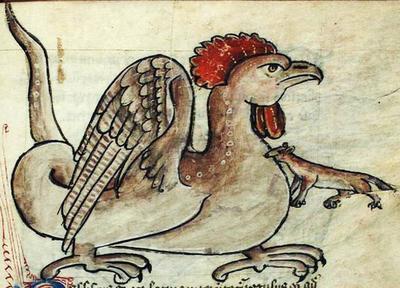
Before the ‘official’ start of Middle Ages, St Augustine mentions the stories about Lycaon and the Lupercalia and the living nine years among wolves (see part 2) in his City of God, book XVIII, chapters 17-18. He is, I think, one of the first writers to state therianthropy is evil and the deed of demons. However, according to St Augustine the transformation doesn’t really affect the mind or body of humans, but he thinks that it’s a sort of vision put into people’s heads by demons. That might have been one of the foundations of the idea that werewolves were actually called by clergy and lords to get the people back to faith if they were ever trying to escape the Claws of the Church.
Wolves
The list of beasts in medieval bestiaries is very very long, yet there are no werewolves. That might be because scholars weren’t interested in the horror part we know since the Renaissance. Besides, the medieval werewolf was a bit different from the one we know today. While retaining the characteristics of a beast, it was merely hiding the human behind. However, wolves existed and so much so that at some points they were a real threat, like during those horrid winters when temperatures went way below freezing point and wolves were entering villages and cities (in the middle of the 15th century in Paris, for instance). They were also pictured as evil animals in the Bible, which meant that they were to be feared and hated: ‘Beware of the false prophets, who come to you in sheep's clothing, but inwardly are ravenous wolves.’ (Matt. 7:15) They were considered stupid and menacing, inedible, useless, and dangerous to people because they could sometimes attack cattle (who would go hunt when food is ready and not struggling too much on the farm?). Wolves aren’t more dangerous than any other wild animal, nor are they useless. About inedible I wouldn’t dare give an opinion. Never tried wolf so far, and don’t intend to.
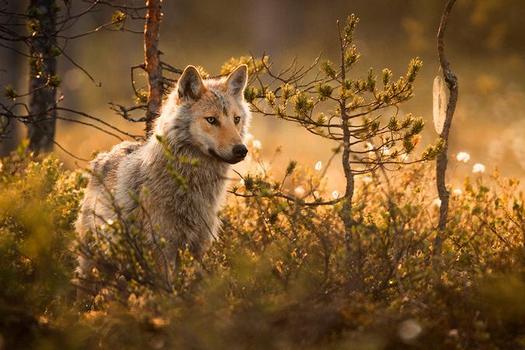
However, wolves were also honoured in many cultures, like Germanic ones. Many names are derived from Wulf or Wolf or Ulf, for instance, with very positive meanings like ‘friend of the wolf’ (Wolftrud) or Atawulfus (wolf-father). And, ô divine irony, three French patron saints in the catholic church are called ‘Loup (French for wolf), Lubin and Lupicin’ (-can hardly refrain from laughing - can’t. -dies of laughter-). OH MY GOD Lupicin du Jura was one guy who was wearing animal skin instead of clothes! and St Loup is the patron of … sit down and breathe, sip some good Scotch Single Malt … of SHEPHERDS! So yeh… I wonder what the Church makes of that. Her own patron saints being labelled by her as evil. What an oxymoron.
Wolves are also a symbol of power and strength in many northern pagan cultures, like the norse one or the Sami one. We’ll discuss that a bit later…
The thing I think that we must remember from this bit is that wolves are a paradox in our society. Both respected and hated for different reasons. A bit like Lupin, after all.
Werewolves
The werewolves weren’t liked either, because the wolf wasn’t, even if werewolves were hardly ever mentioned. However, the word appears in places I wouldn’t have expected, like King Knut’s law codes (1018-1021, Oxford, Winchester) in which the word refers to an outlaw, that is, someone who is beyond the community’s responsibility because they can’t abide to the law. There’s also a quote from those laws I found in French, that I’ll translate here as well as I can: ‘There’s no more damageable being than the Devil himself … shepherds must be on their guard … so that hungry werewolves don’t strangle and bite members of their spiritual flock’ (Knut the Great, Laws, I § 26, in Lecouteux, 2008 - I tried to find something online but meh).
Middle Ages was also the period of our History when Alchemy was developed. The Grand Oeuvre included of course the making of the Elixir of Life and the Philosopher’s Stone, and alchemists used the werewolf to symbolise the transformation of vile metals into gold… because the werewolf, besides his devilish reputation spread by the Church, had a noble descent in the wolf, who was, in spite of everything, honoured and considered noble. The grey wolf itself was an important symbol in Alchemy: Antimony (chemical symbol Sb; the wolf is also called Lupus metallorum). The whole of this is, of course, no paradox :P.
The Middle Ages also tried to explain the werewolf, and discussed if they could breed and what would become of them. Well, Rowling says the cub of a werewolf wouldn’t be one, and the cub of a werewolf couple would be a wolf. Sort of makes sense. Being a werewolf isn’t genetic, since only the blood is infected, but again, there can be contact between the blood of the mother and that of the cub, and that of both parents with each other’s...
Some sources in the late Middle Ages (Evangile des Quenouilles, in Lecouteux, 2008), says that ‘if a man has as a destiny to become a werewolf, it’s rare that his son wouldn’t be one’. Another tale, this one from Masuria in Poland, tells the story of a boy who had inherited the ability to transform from his father. In this tale there’s nothing linking the transformation with full moon, though. The boy has to flip jump over a stump, though, to transform. I actually found an even earlier text (10th century) from Ireland that says that some men can change shape at will from generation to generation. The only condition is that when they transform, their body shouldn’t be moved in any way, because otherwise they couldn’t return to their human shape. If the wolf happens to be wounded during its wanderings, then the wound would appear on the man’s body at exactly the same place. When it comes to explanations, scholars said that full moon was a psychological shock, and that it could be one of the reasons explaining the phenomenon. From the late 12th century, being ‘possessed’ is a very good reason for being a werewolf, and of course this leads to links with devilish practices and witchcraft; the werewolf is a sorcerer who transforms into a beast to do as much harm as possible to his fellow humans. Naturally, this suspicion of witchcraft or any form of magic leads to the idea that balms are used to transform, which is something very frequent. Even men on trial would confess using some kind of magical ointment. The link with witch-hunts is easily made...
Something is a bit odd in all this, though: the fact that some think that actually the body is not transforming, but that it’s the soul that leaves the body and wanders alone in the shape of a wolf. This is something I didn’t expect to find in Central Europe. In my mind it refers more to northern American, European or Siberian native shamanic cultures.
Punished by God
Many medieval texts relate the fact of becoming werewolves as a godly punishment. One of them is about St Patrick. When the priest undertook to convert Ireland to Christianity, there was one tribe that opposed more fiercely than others, and they howled like wolves to Patrick. Patrick then prayed to God that he would punish these people for their blasphemies and their ill-will at receiving the truth of his god, and God decided to punish the tribe by changing them into wolves for a set period of time (either a winter every seventh winter or seven years, depending on the tale). These wolves were told to be more dangerous than natural wolves, because besides their ability to kill, they retained their human brain and could act wild and clever against both cattle and men.
This story goes against the idea that werewolves lose their human part when transforming. There’s a similar story in Norway, also involving St Patrick.
Werewolves ‘by birth’: the Lays and other stories
However, in medieval stories like the Lays by Marie de France and other similar ones, the werewolf is not The Beast, as it is now. The actual bestial aspects are mostly being downplayed. The stories retain more of the human part of the werewolf, as if the beastification couldn’t be complete. Meaning that the werewolf still can reason and judge, and that’s seen mostly when the werewolf attacks, because he never attacks without purpose: usually revenge or the aim to unveil a culprit or identify it. I think the main cause of this is that being a werewolf in those stories is not exactly a curse. You need not have been bitten to be one - or let’s say that nothing is told about that. There’s no dark magic at work. It’s more like a condition you can’t escape and we don’t know where it stems from.
Medieval werewolves were usually male. There is, however, a tale concerning a she-werewolf in Ireland. It is found in Geraldus Cambrensis’s account of the voyages of Prince John to the Green Island. It is a tale that usually goes by the name of the Werewolves of Ossory. Here’s the tale:
In Ireland, there is a strong werewolf-related mythology. According to Geraldus Cambrensis, there are stories about werewolves living in packs in deep forests, sometimes asked for help by local kings in their internal wars. But there’s also this tale about a dying she-werewolf in Ossory.
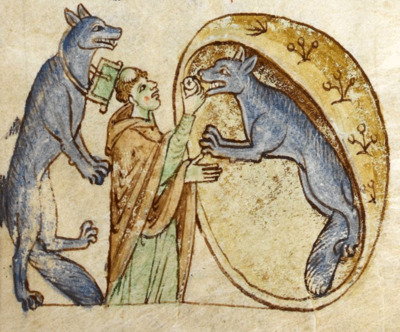
It all starts with a priest travelling down from Ulster to Meath. He stopped in a forest near Ossory to set up his camp for the night with the clerc boy who travelled with him. The darkness fell and suddenly a voice came from among the trees, calling: ‘Father!’ several times. The priest asked who it was. ‘It is a penitent sinner who seeks only your blessing,’ said the voice. The priest asked the voice to step out into the firelight if they were indeed a repentant sinner. At first the voice refused, pretexting that they were so ugly the priest would run away. A long dialog ensued, where the priest repeatedly asked the voice to come closer and the voice continuously told him he’d be disgusted, whatever the priest would say. Then he added ‘it is not for I that I seek absolution but for she who cannot come.’ Then the priest asked if he was diseased in some way. ‘In a fashion,’ replied the voice. The priest still tried to convince the voice to come forward, and in the end a wolf stepped out into the light and went on speaking with the same voice and polite tone as before.
The priest was shocked and choking with fear, whatever he had told the voice before. The wolf explained: ‘I am under a terrible curse. I must wear this form for seven years before getting back to look like you. Yet in my heart I am still a Christian, and in need of your help and blessing.’ The priest was aghast. ‘Can you vouch for this with all your heart?’ he asked the wolf. ‘Aye, I can. Although we wear this form we are human and in the same need of salvation as any other. I am a member of Clan Allta. It is a tribe of this region. Like you, Father, we believe in God. We were cursed a long time ago for an old sin by the abbot Natalis.’ This was a known name to the priest, who then listened to the wolf more willingly. The wolf went on: ‘My wife and I were chosen to bear the curse over six years ago, but now my wife is dying, hurt by an arrow. She lies in a place not far from here. I beg you, come and minister to her.’
The priest was upset, and the wolf was polite and pleeding. He followed him to his lair. There was a she-wolf, badly wounded. She asked the priest to hear her confession and give her the holy viatic. She had to talk to the priest a long while until he was finally convinced that it wasn’t a trick of the Evil One to lure him out of the paths of God. To be really sure, he said: ‘if only I could see the human in you’. At these words the she-wolf started gnawing at her forepaw and while blood spurted around, the priest saw human fingers appear under the wolf-skin. Then she proceeded to remove more of her wolf-skin. The head appeared and finally the priest believed her and gave her what she had been asking for.
On his way back from Meath, over a year later, the priest stopped in the same woods and went to look for the wolf, but never found a trace of him.
During trials in France, of which there are about 250 accounts (between the years 1423 and 1720), a third of the accused were women, but the charge of their being wereshewolves was generally changed into their being witches, hence the idea that there were no female werewolves I suppose.
So basically, during the Central European Middle Ages, the werewolf was considered the anti-man, the bad and evil side of us, mainly due to the influence of the Church, because according to them, Man is the image of God, and the werewolf, being the deed of a demon, can’t be the image of the revered deity.
I’m going to tell you the well-known story of Bisclavret, because it’s the most popular. If I find more tales worth telling (that is, adding something to what has already been said here) I’ll edit the text.
Bisclavret, Sir Marrok and Tiodel’s Saga
European Middles ages aren’t very prolific in werewolf stories until the 14th century. Before that, we have about four French stories, among which one that has been mentioned and adapted in England and Iceland.
The story is about a werewolf, but apparently not a bad one. Nothing is told about what happens while he transforms. Bisclavret was written by Marie de France in the 12th century, based, according to her, on a story she heard in French Brittany. It’s one of her twelve Lais, a monument in French literature. Bisclavret means werewolf in Breton language. However, there’s another word for it too, and Marie makes a distinction when she uses them. Apparently ‘Bisclavret’ is used only for that knight in the story, whereas the other word, ‘garwaf’, is used to refer to the more common understanding of the word. To the tale, then.
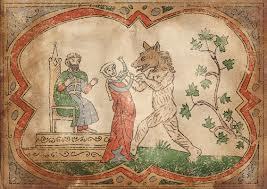
Bisclavret was a Breton knight, well loved by the king. The tale goes he disappeared every week for three days (notice it’s got nothing to do with full moon). Nobody knew where he went, not even his wife. One day, his wife begs him (probably for the umpteenth time) to tell her what happens. He does oblige, and goes unfortunately as far as to reveal the fact that he must lay his clothes in a particular place to get them back on the third morning, otherwise he can’t go back to human form. You can imagine the lady’s state of mind. She is not only upset, but also angry, and shocked. She tries to find any way to get rid of this man, and comes up with stealing his clothes. She sends a knight whom she knows is in love with her to do the deed. When he comes back with the clothing, she marries him. A year later, the king goes hunting and his dogs corner Bisclavret. The wolf has a really strange behaviour: it comes to the king, begging him for mercy, kissing his feet. The king decides to be generous and takes Bisclavret to his castle to live with him. On two different occasions did Bisclavret attack people. When he saw the knight who had married his wife, and when the king took him to visit his former wife, who got her nose torn off. Both the knight and the wife were punished. The king, who was told by his advisers who the two attacked people were, makes the wife confess the whole business. Thus can Bisclavret get his clothing back, change and return to human form, to the great happiness of the king. It is said that all the offspring of the wife were born without nose from that day.
The tale of Bisclavret is mentioned twice and very briefly, without mentioning names, in Thomas Malory’s Le Morte d’Arthur, written in the 15th century (published 1485) and has been translated and then adapted in Old Norse under the title Tiodel’s Saga. The werewolf in Le Morte d’Arthur is sometimes called Sir Marrok in other works, and particularly since Allen French made the two sentences in Malory’s tale into a 300-page book in 1902 (for the link to the full text, see sources).
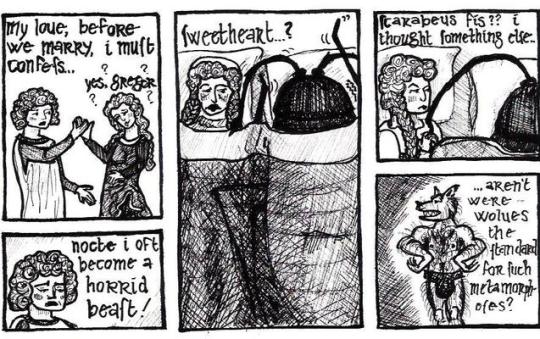
Melion
We don’t know who wrote the lay of Melion. He’s described as a word-player, inferior in quality to Marie de France, who wrote Bisclavret. It was written probably between 1190 and 1204, reset in the Arthurian world. Like in Bisclavret, the werewolf is presented like a sympathetic bloke who has been wronged by his wife and is later ‘saved’ by a king. Here’s a summary of the story:
Melion was a knight at King Arthur’s court. He vows never to marry a woman who has loved before or who has spoken of another man. As a consequence he’s ostracised by all the ladies at Arthur’s court. To comfort him, Arthur gives him land and Melion goes hunting there and soon gets cheerful again.
One day, during his hunt, he meets a lady riding in the forest who claims to be the daughter of the king of Ireland, and of having never spoken of a man before, nor loved one, but Melion. All besotted, Melion marries the lady and they have two children over three happy years.
During one of their hunts, with one of their squires, Melion and his wife see a magnificent stag. The wife gets into a tantrum and swears she will die if she doesn’t eat the meat of that stag. Melion, distressed, promises to get the stag, if he transforms into a wolf, using a ring with two magical stones on it. Melion undresses and asks his wife to keep his clothes and ring safe after he’s transformed so that he can get back to his human form. Then he asks her to touch his head with one of the stones. There goes Melion in a wolf-form behind the stag, a wolf with a human mind.
At once the wife rides to the harbour and to Ireland with the squire. When Melion comes back, he can’t find his wife. He follows her, knowing she would go to her home country. There he starts killing cattle and sheep, so much so that peasants go to the king to complain. The king kills the wolves, but not Melion. The latter is despairing because he can’t get revenge.
One day, though, his hopes rise: there’s a ship approaching the coast: it’s Arthur, who sets camp on the coast. Melion enters Arthur’s tent and lies down at his feet. Melion refuses to be separated from the king. The day after, Arthur and his court, including the wolf, go pay a visit to the king of Ireland. At court, Melion spots the squire whom his wife had run away with, and attacks him. Of course, Melion is threatened, but some say wait, because there must be a reason for such an attack by such a tame wolf. The squire is forced to confess. The ring is brought back to Melion, who can transform to his human self, and returns with Arthur to Britain, without his wife.
The same sort of comments can be made about this text and Bisclavret. After all, they are rather similar, and the scholars say they stem from the same source. Moreover, there is a lot of writings about those lays, the misogyny is debated as well as the knighthood. Sometimes the wife is described as the human counterpart of the werewolf… but that is another story.
And Greyback and Lupin?
In these tales, the werewolf is not bad per se. Only does he seek revenge from those who mistreated him. So nothing in here links the werewolf with either Fenrir or Greyback, apart maybe the idea of revenge, which is nothing particular to werewolves. Yet Greyback started to attack out of spite and for revenge against mankind, and Fenrir was to kill Odin at Ragnarok because of the treatment the gods had been inflicting him. So yeh… some sort of revenge against injustice or an unfavourable fate… Of the two, though, Fenrir is the closest to both Melion and Bisclavret, because he goes for only the one responsible for his fate. Greyback, on the other hand, develops a hatred against mankind so deep he can’t stop himself and actually grows unnaturally into liking his condition. Dumbledore asks him, on the top of the Astronomy Tower, Half-Blood Prince: ‘This is most unusual… You have developed a taste for human flesh that can’t be satisfied once a month?’ and Greyback answers: ‘That’s right. Shocks you, does it? Frightens you?’. Dumbledore is disgusted, as would anybody, I reckon.
Besides, we don’t know what makes the man change into a wolf. The only two things that seem to be important are exiling oneself to the deep of the woods and getting naked. This is in complete contradiction with Greyback, for instance, who positioned himself next to his coming victims to transform and be sure of getting to bite them. Lupin, while at Hogwarts as a student, was led to the Shrieking Shack by Madam Pomfrey, but that was only because the transformation could be scheduled since it was directly linked to the phases of the moon. The nakedness isn’t important in the Harry Potter books either. Lupin transforms without removing his clothes because he hasn’t time to do so in Prisoner of Azkaban. Again, I think this is related to the fact that in the Harry Potter books there’s no ‘magic’ to transform (whereas Melion needs the ring), apart from the power of the moon and the curse in the blood. No somersaults, no running in circles, no peeing, no spells.

Sources for part 3
Page 394
French, Allen, The Tale of Sir Marrok, 1902:
https://ia802305.us.archive.org/14/items/sirmarroktale00frenrich/sirmarroktale00frenrich.pdf
Hopkins, Amanda, Melion and Bisclarel, Two Old French Werwolf lays, Liverpool online series, University of Liverpool, 2005 https://www.liverpool.ac.uk/media/livacuk/modern-languages-and-cultures/liverpoolonline/Werwolf.pdf
Lecouteux Claude, Elle courait le garou - Lycanthropes, hommes-ours, hommes-tigres, une anthologie, José Corti, Paris, 2008
Pottermore, Remus Lupin: https://www.pottermore.com/writing-by-jk-rowling/remus-lupin
Pottermore, Werewolves: https://www.pottermore.com/writing-by-jk-rowling/werewolves
Rowling, Joanne K., Harry Potter and the Prisoner of Azkaban, Bloomsbury, London, 1999
Rowling, Joanne K., Harry Potter and the Half-Blood Prince, Bloomsbury, London, 2005
St Augustine, City of God, 426 A.D.:
http://www.unilibrary.com/ebooks/Saint%20Augustine%20-%20City%20of%20God.pdf
The Bible.
The Medieval Werewolf: https://www2.warwick.ac.uk/fac/arts/ren/news_and_events/researchblog/werewolf/
The Werewolves of Ossory:
http://www.irelandseye.com/aarticles/culture/talk/banshees/werewolf.shtm
Wikipedia, Bisclavret: https://en.wikipedia.org/wiki/Bisclavret
#Louhi#Harry Potter#Werewolves#Middle Ages#Ireland#France#Marie de France#Lais#Mellion#Bisclavret#Ossory#Greyback#Lupin#J.K. Rowling
0 notes